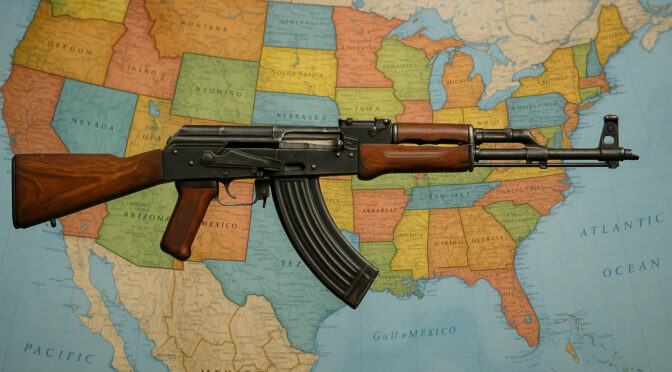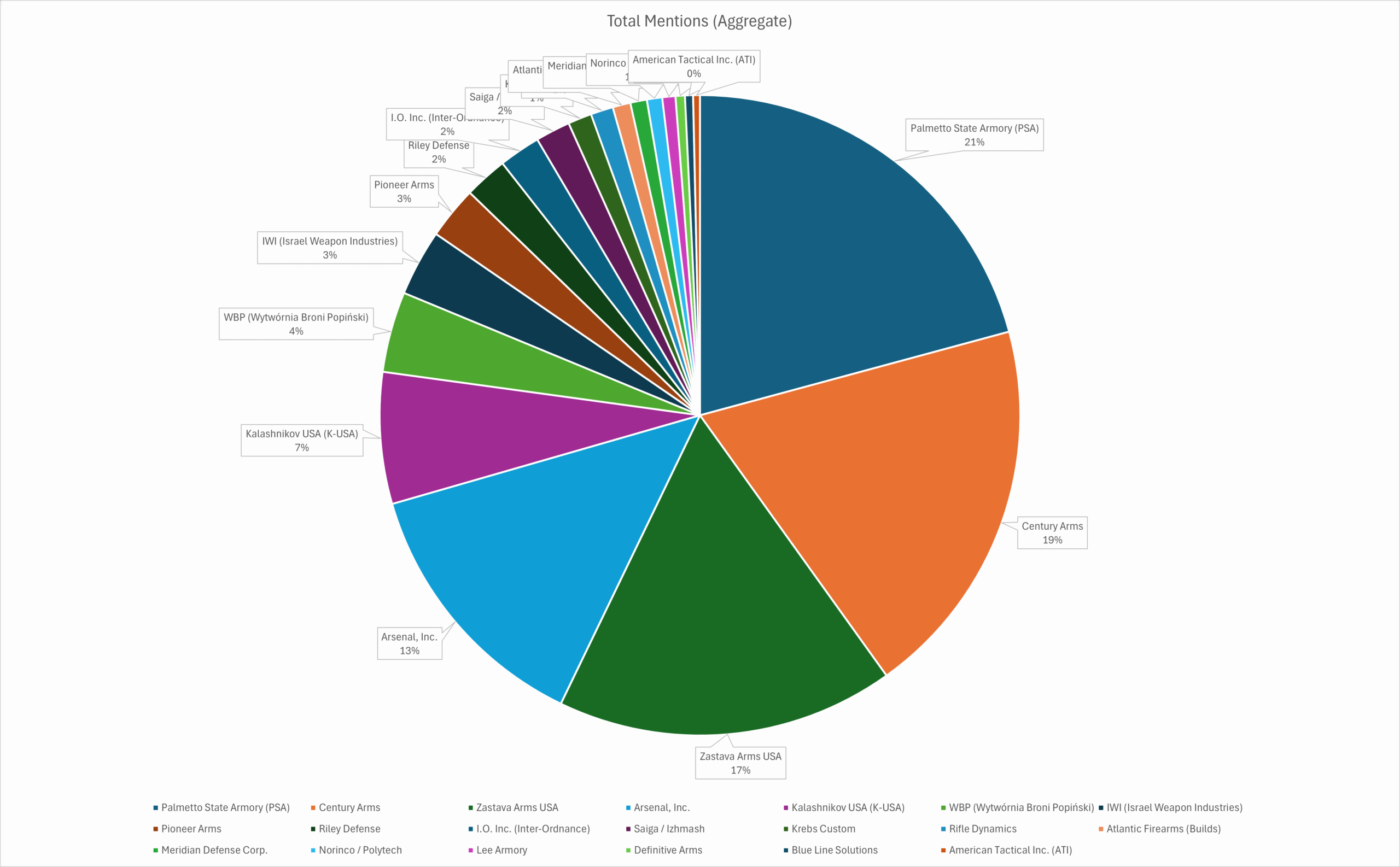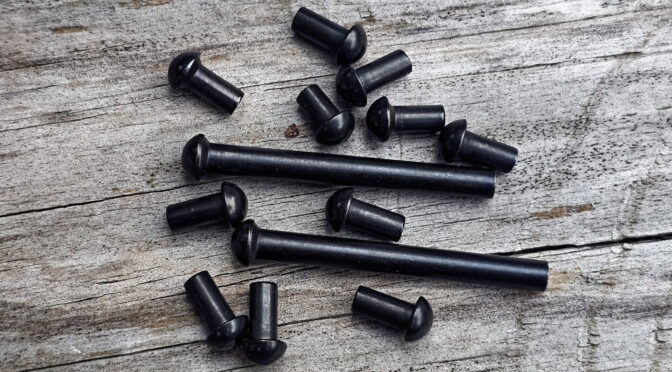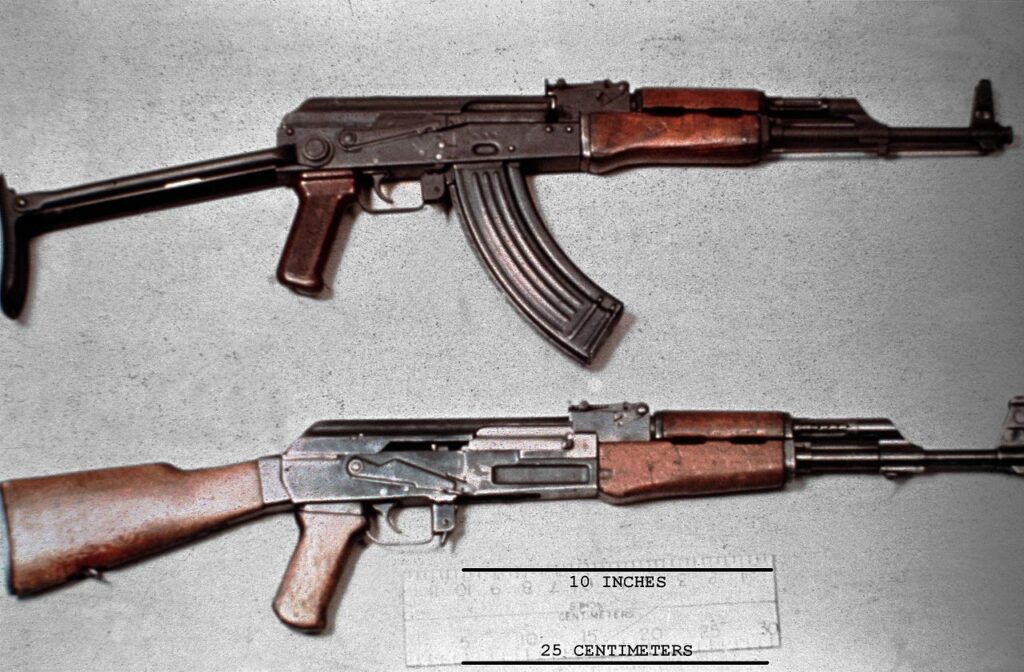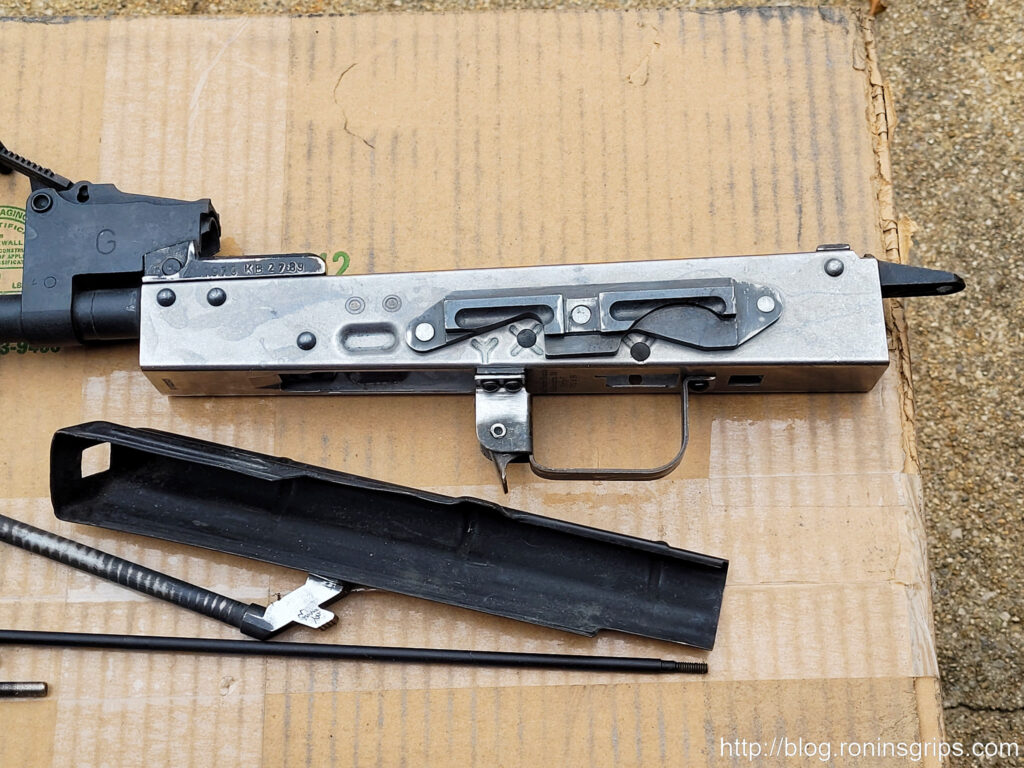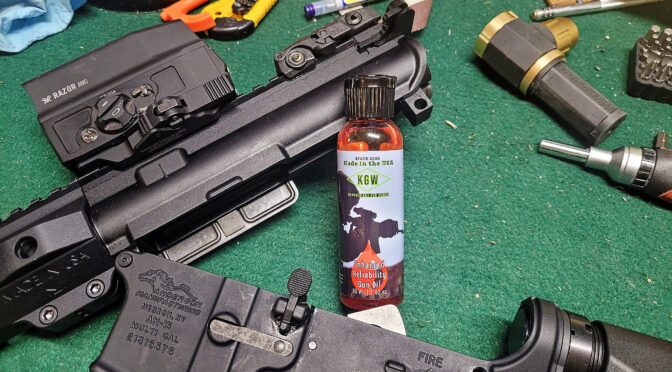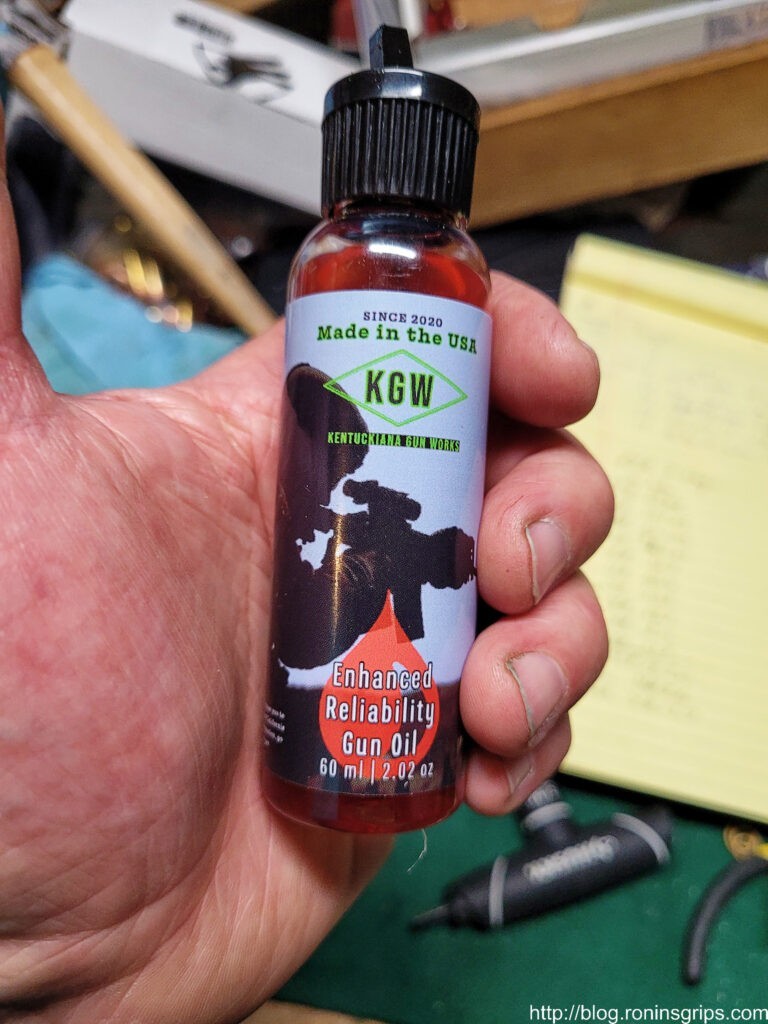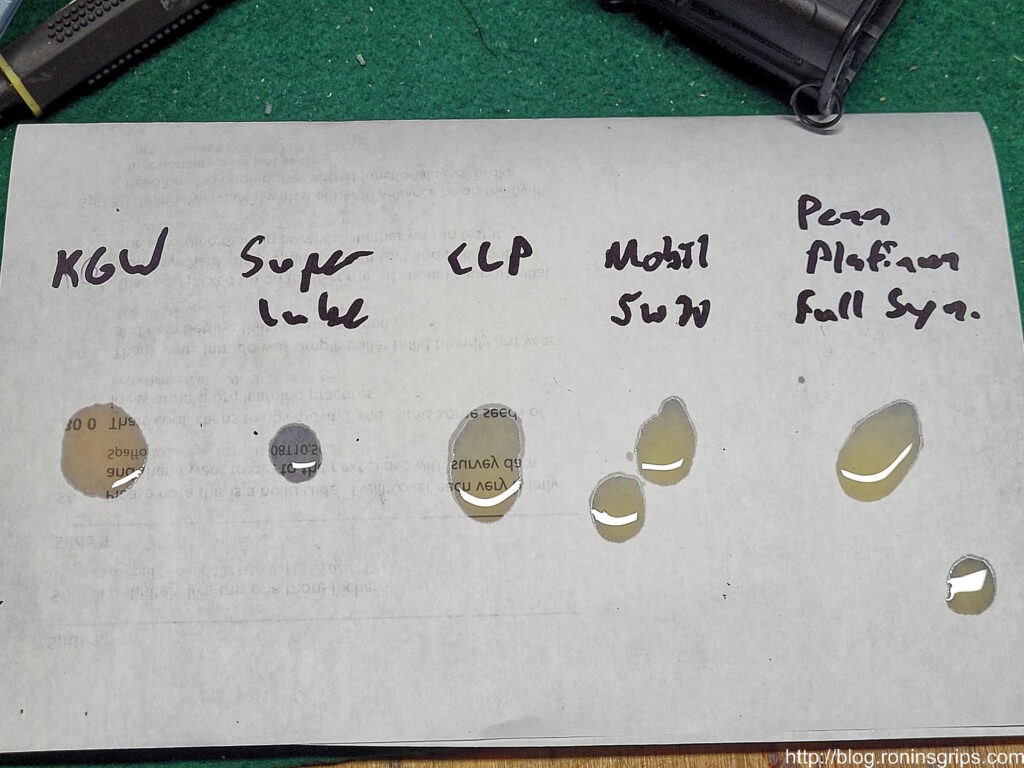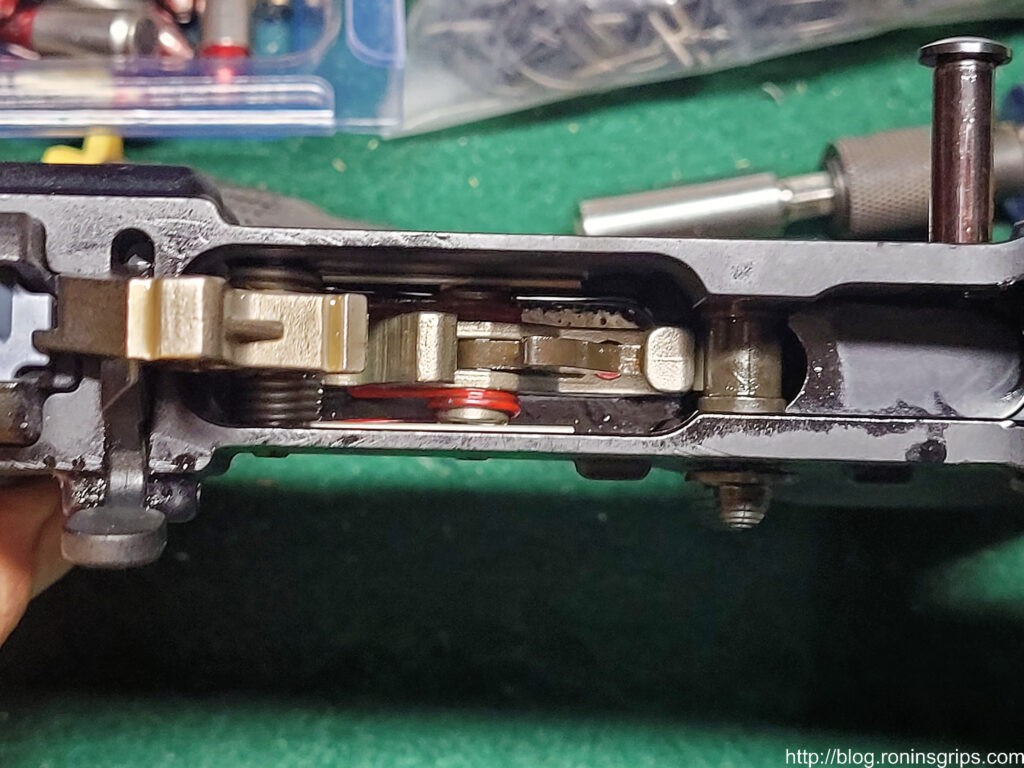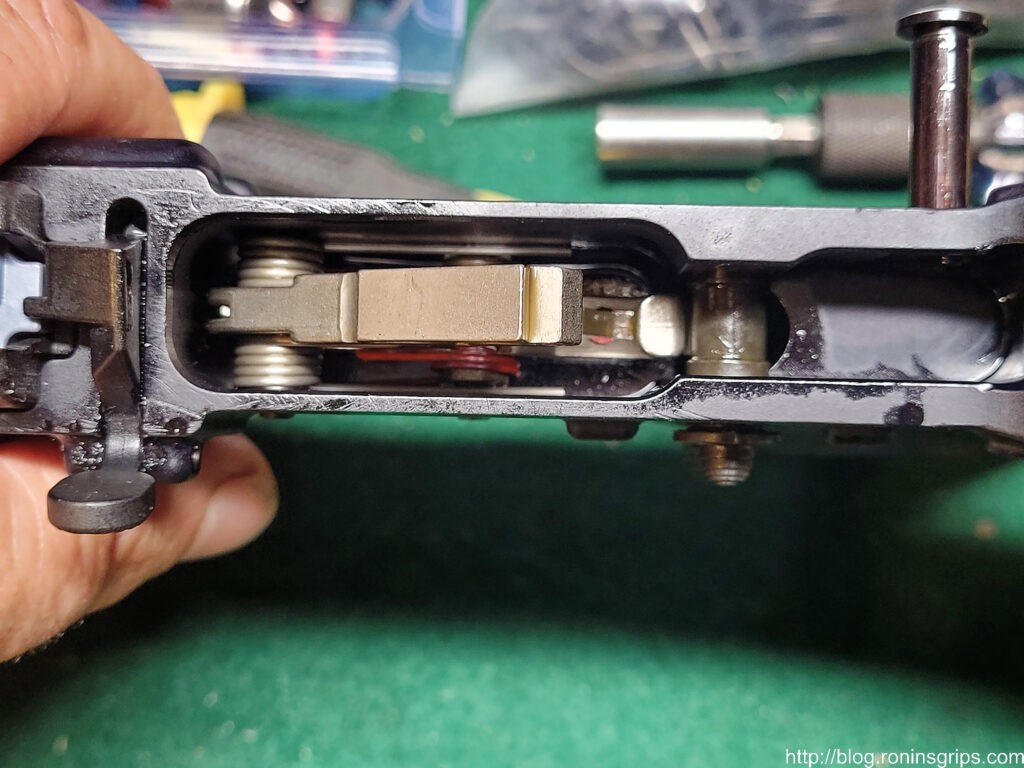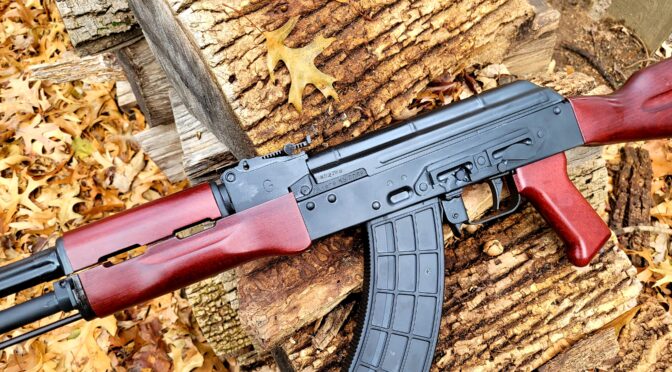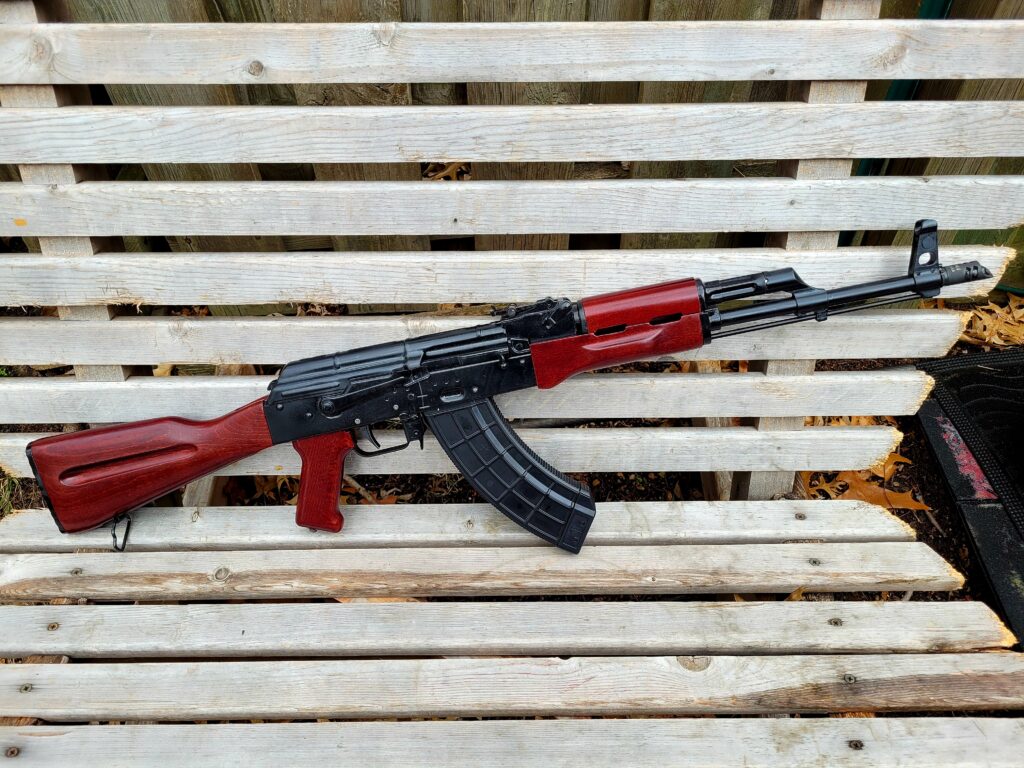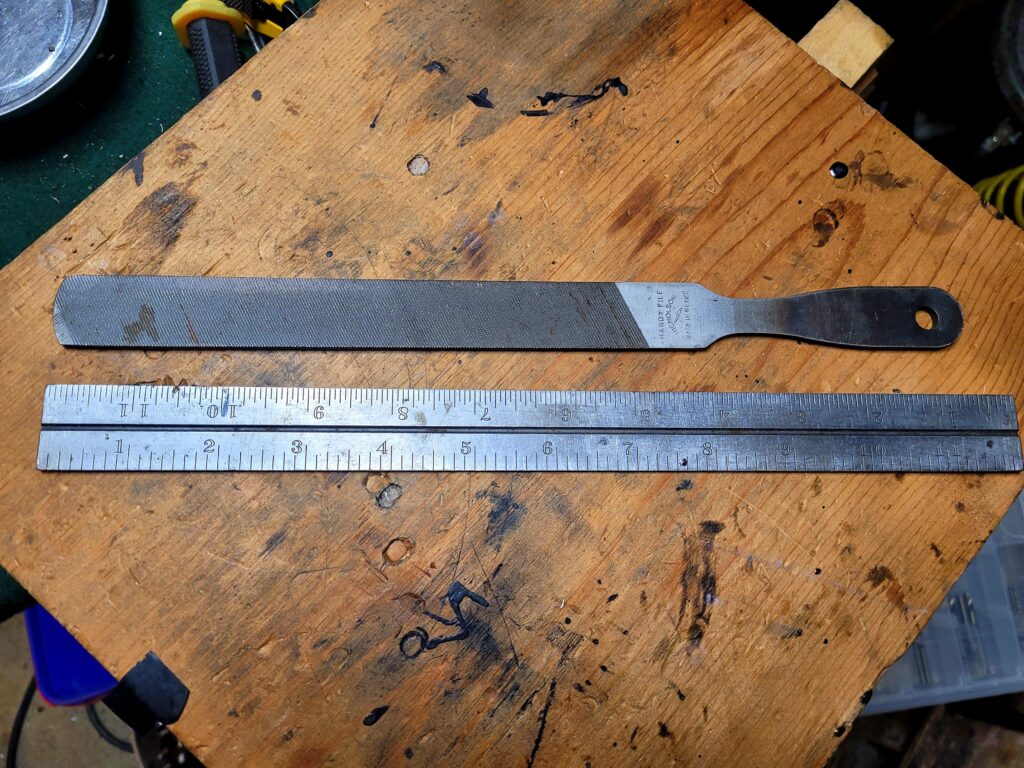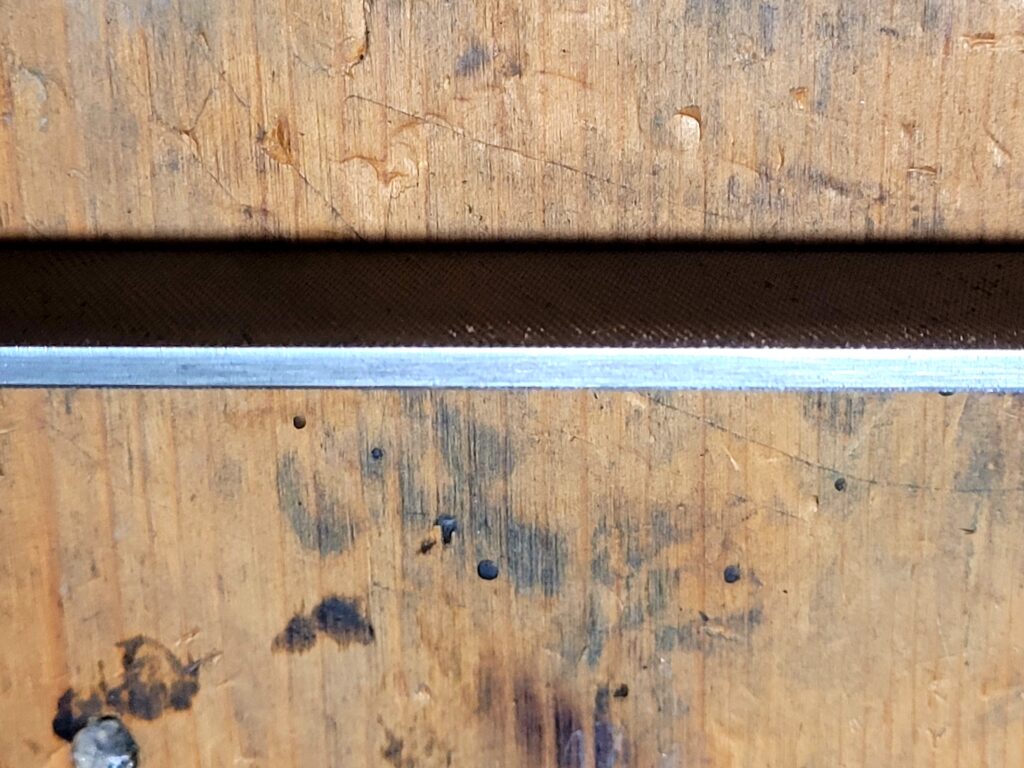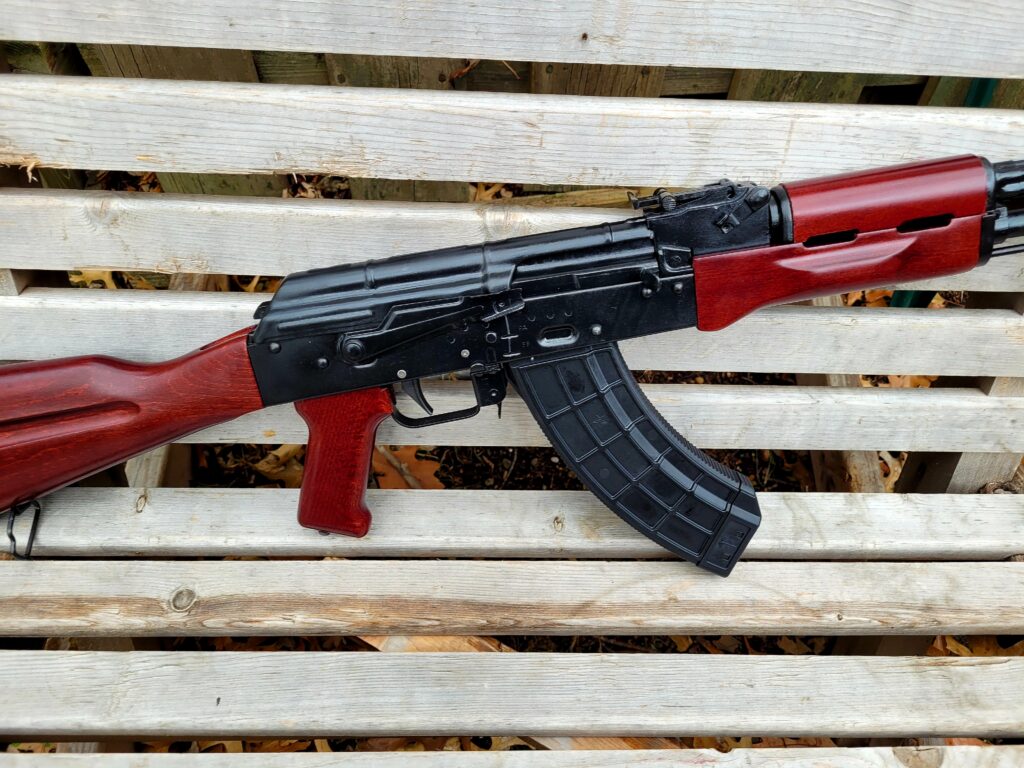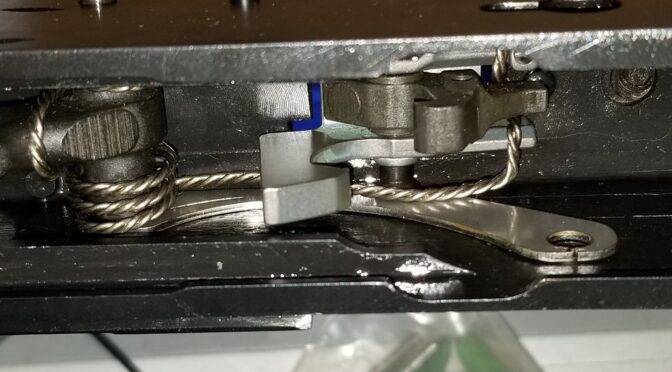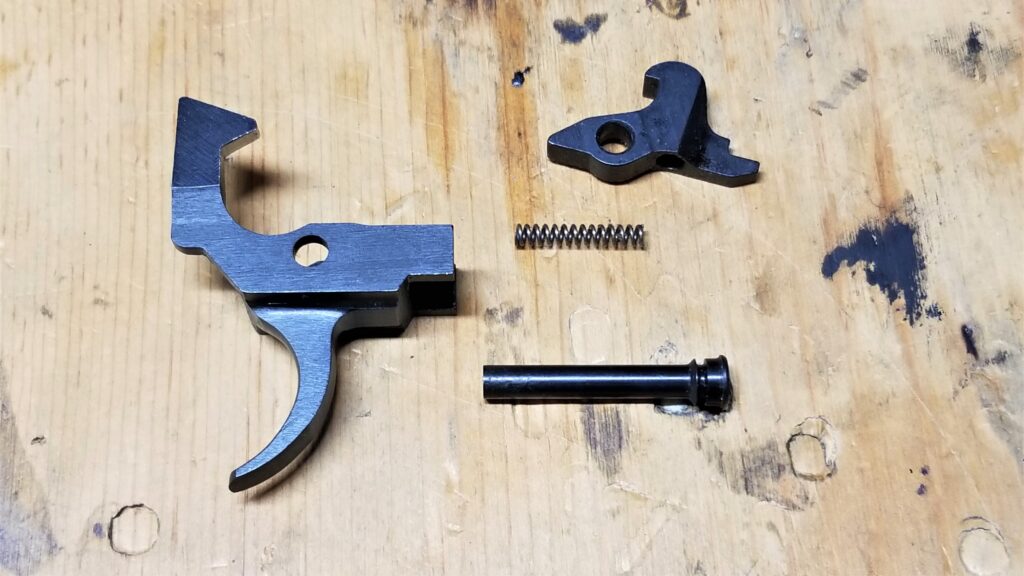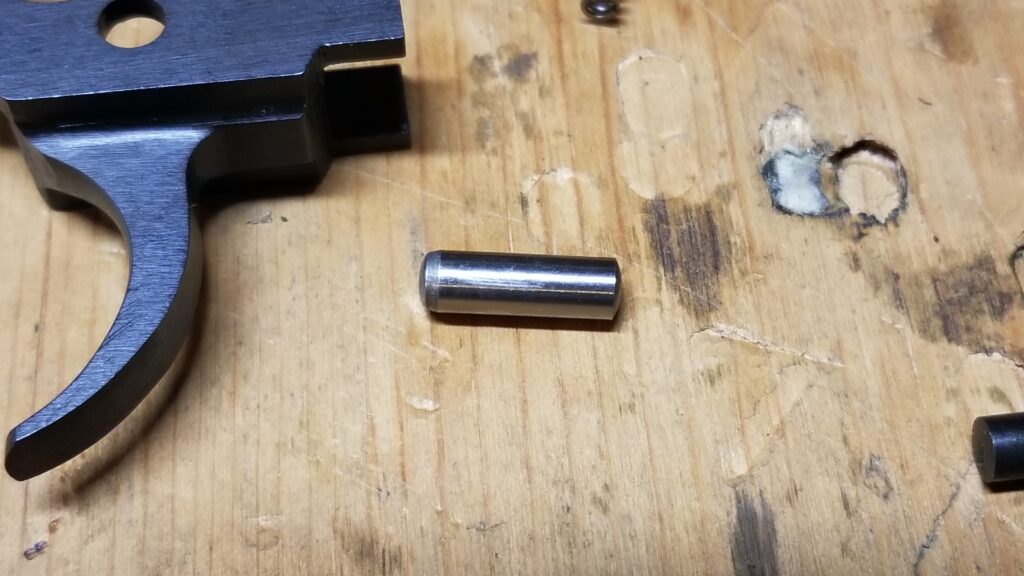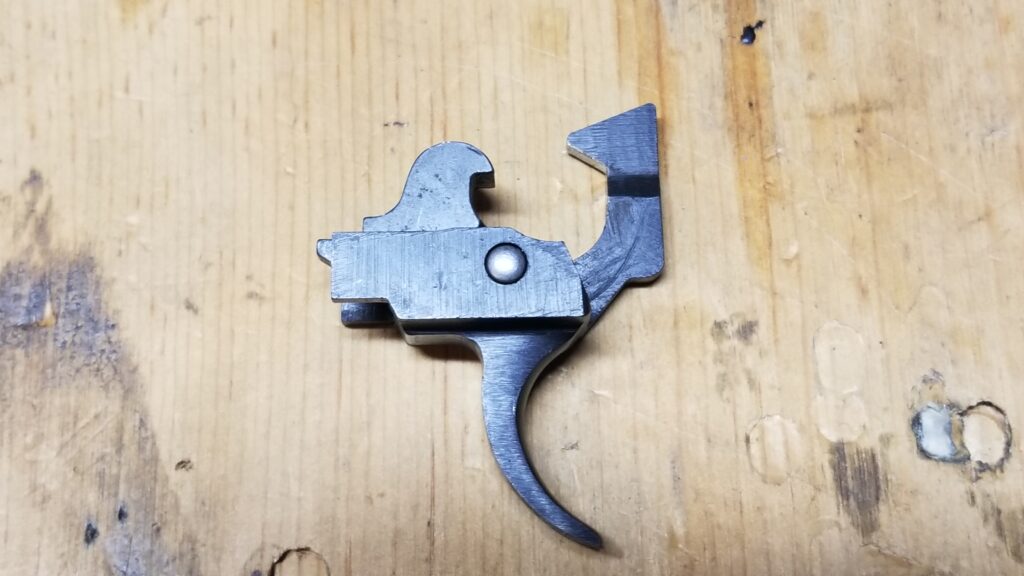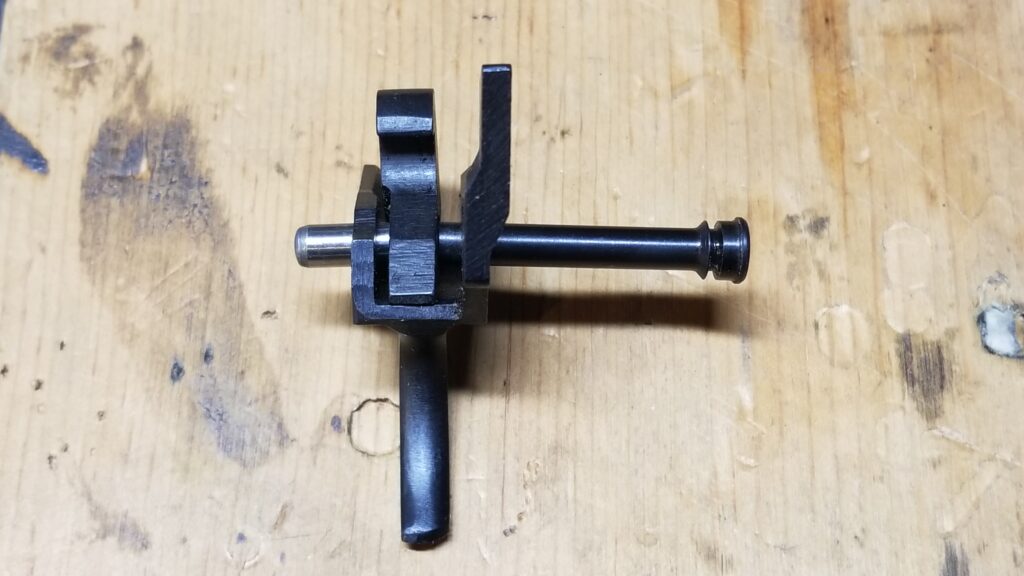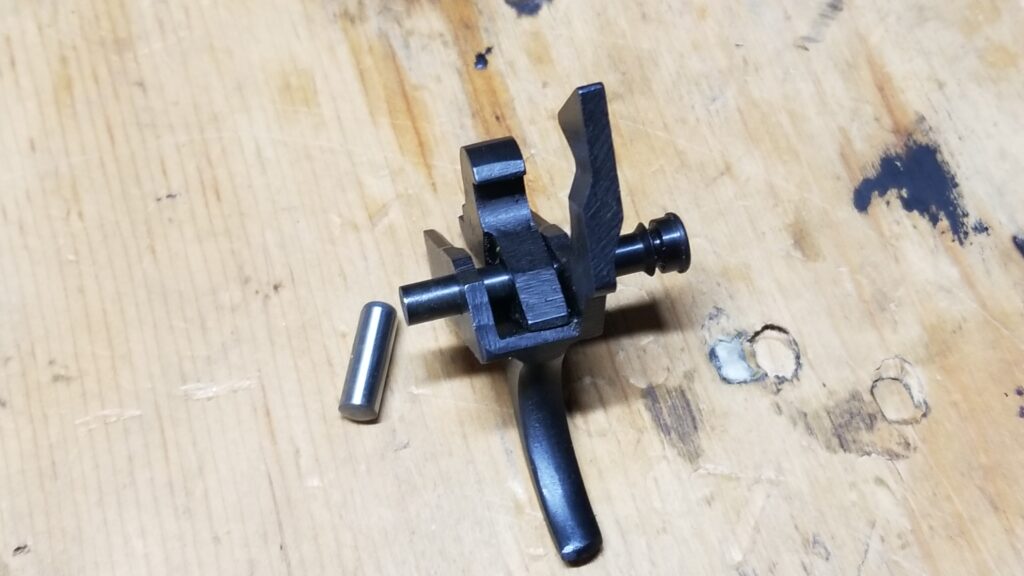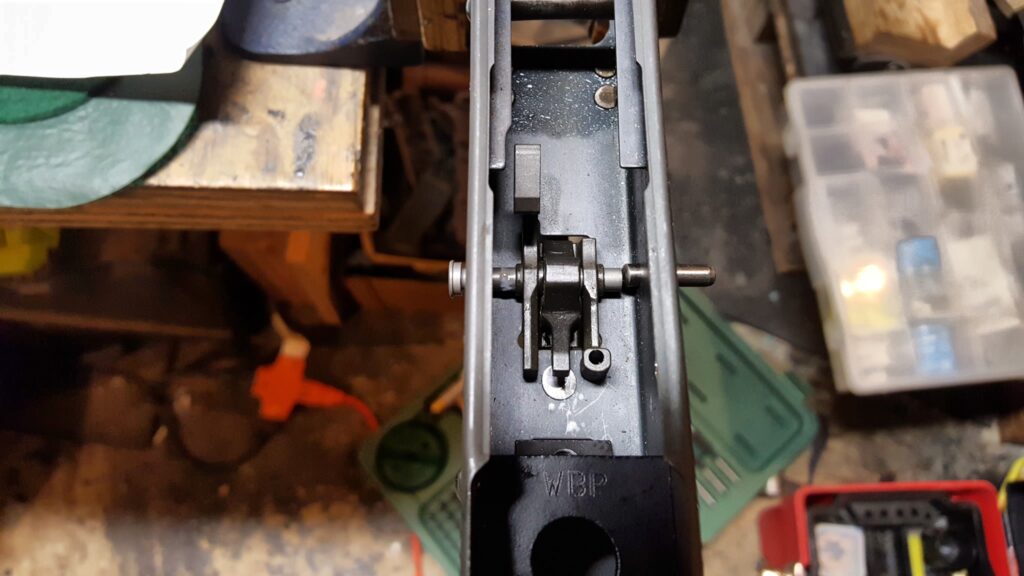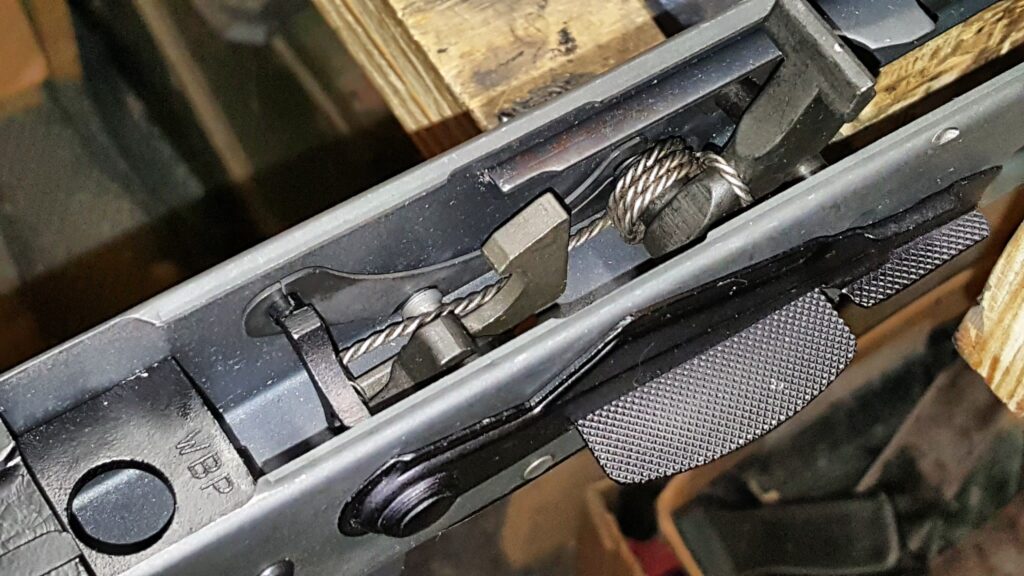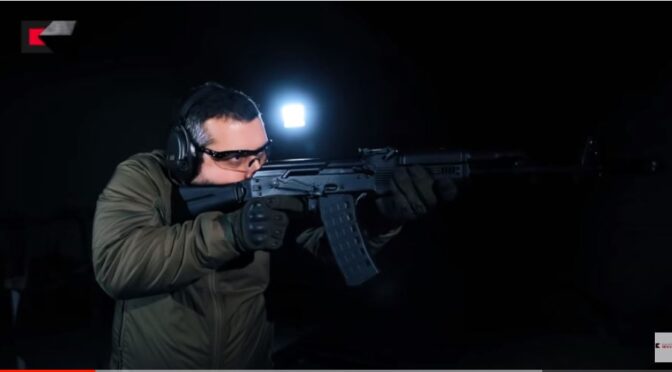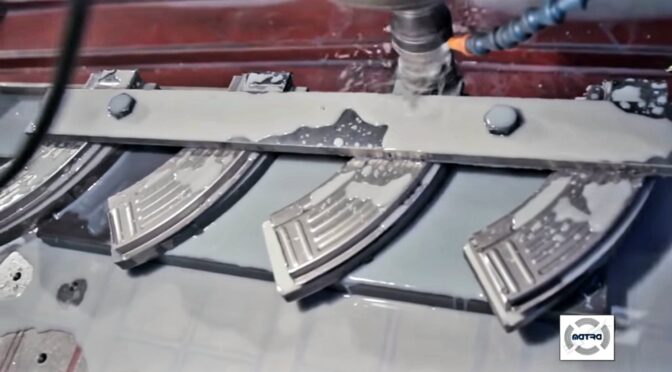Ever get tired of trying to figure out what AK vendors might be worth buying a rifle from in the US? Well, I did but the thing is that I have the tools and experience to do something about it – namely a formal customer sentiment analysis.
What I did was to have my analytics tools look at 512,000 online discussions for 2020-2024 and through July 12, 2025. I then had it identify the AK vendors mentioned the most online in social media, how often they came up in discussion, the % positive and the % negative.
What does this give you? An unbiased list. You’re getting the data without me tampering with it, injecting my opinions or getting paid by vendors to put their name on a list. Use this to consider how a given vendor is trending (are discussions getting better or worse).
| This post has a companion post that contains relative performance rankings for 50 vendors in the AK market including rifles, accessories and receivers. Reading both will give you additional insight. This post looks at the volume of discussions in social media and the percents positive and negative. The other posts looks at a number of attributes including price, reliability, finish, customer service and so forth and assigns a relative ranking from 1 (low) to 10 (high) for each vendor. Click here to open that post in a new tab. |
Executive Summary
This report presents a comprehensive market intelligence analysis of the United States civilian Kalashnikov-pattern (AK) rifle market, covering the period from January 1, 2020, to the present date in 2025. The analysis is based on a wide-ranging review of online discourse, including enthusiast forums, news media, and product reviews, to quantify consumer sentiment and track brand performance over time.
The US AK market is characterized by a fundamental and persistent split between imported and domestically manufactured rifles. Imported firearms, particularly those from legacy Combloc factories such as Zastava (Serbia) and Cugir (Romania), are held in high esteem for their perceived authenticity, robust build quality, and use of military-grade components like cold-hammer-forged (CHF), chrome-lined barrels.1 This perception grants brands like Arsenal, Inc. (importing from Bulgaria) and Zastava Arms USA a significant reputational advantage, allowing them to command premium prices.
Conversely, the domestic manufacturing sector has undergone a significant transformation. Early US-made AKs from manufacturers like I.O. Inc. and Century Arms (specifically the RAS-47) established a poor reputation due to the use of inferior cast components, leading to well-documented catastrophic failures.4 However,
Palmetto State Armory (PSA) has spearheaded a redemption arc for American AKs. By transitioning from early models with cast parts to the widely accepted GF3, GF4, and GF5 series featuring forged trunnions, bolts, and carriers, PSA has successfully shifted market perception and captured a dominant share of the domestic market through aggressive pricing and a vast product catalog.2
A key macro-trend impacting the market is significant price escalation across the board. The AK platform, once considered a budget-friendly alternative to the AR-15, now occupies distinct market tiers ranging from sub-$800 entry-level models to premium offerings exceeding $2,000.2 This shift has been compounded by geopolitical instability and US import policies. The memory of bans on Russian firearms (Saiga, Vepr) and the recent 2025 suspension of arms exports from Serbia have underscored the fragility of the import supply chain.9 This uncertainty has increased the strategic value of readily available, domestically produced rifles, fundamentally altering the consumer purchasing calculus.
The dominant brands in terms of discussion volume and market impact are Palmetto State Armory, Century Arms, Zastava Arms USA, and Arsenal, Inc. PSA leads in domestic volume, Zastava in import quality-for-value, and Arsenal in the premium milled-receiver segment. Century Arms occupies a complex position, with its imported Romanian WASR-10 being a perennial favorite workhorse, while its US-made VSKA continues to battle a legacy of skepticism despite improvements. The recent bankruptcy of Kalashnikov USA, once a promising premium domestic player, serves as a stark cautionary tale about the importance of operational stability and customer support in this high-information market.6
Consumer sentiment is primarily driven by a few key technical attributes. The use of forged components and CHF, chrome-lined barrels is a non-negotiable baseline for quality in the minds of most consumers.2 Quality control (QC), reliability, and adherence to established patterns (AKM vs. the proprietary Yugo pattern) are also critical drivers of brand perception.
Looking forward, the market presents opportunities for a premium domestic manufacturer to fill the void left by Kalashnikov USA and for a value-oriented domestic brand to create a true “WASR-killer.” However, success will require an unwavering commitment to quality control and a deep understanding of a discerning consumer base that values proven durability above all else.
The Evolving AK Market Landscape (2020-2025)
The American civilian AK market has undergone a period of profound change between 2020 and 2025. What was once a relatively stable niche dominated by a handful of importers has evolved into a dynamic, multi-tiered ecosystem shaped by the competing narratives of import authenticity versus domestic innovation, significant price inflation, and the ever-present influence of global geopolitics. Understanding these macro trends is essential for contextualizing the performance of individual brands and anticipating future market shifts.
The Great Divide: The Enduring Narrative of Import vs. Domestic
The most significant and enduring dynamic within the US AK market is the clear division between imported rifles and those manufactured domestically. This is not merely a matter of origin but a deep-seated narrative about quality, authenticity, and durability that directly influences consumer behavior and pricing.
Imported rifles from traditional Eastern European arsenals carry a powerful “Combloc” pedigree. Brands like Arsenal (Bulgaria), Zastava (Serbia), and the Cugir-made WASR-10 (Romania) benefit from the perception that they are produced in factories with decades of military manufacturing experience, using original tooling and superior metallurgy.1 Consumers consistently express a willingness to pay a premium for this perceived authenticity and the “proven” nature of these designs.10 Features like cold-hammer-forged (CHF), chrome-lined barrels are considered standard on these imports and are a major driver of positive sentiment, as they are associated with military-grade longevity and corrosion resistance.2
In stark contrast, the domestic AK market has been engaged in a long and arduous journey of redemption. The initial wave of American-made AKs in the 2010s was plagued by catastrophic failures. Rifles like the Century Arms RAS-47 and offerings from I.O. Inc. used cast trunnions and bolts, which were prone to rapid wear, loss of headspace, and, in the most extreme cases, explosive disassembly.4 These failures created a deep and lasting skepticism toward American AKs within the enthusiast community.
The turning point in this narrative can be largely attributed to Palmetto State Armory. Recognizing the market’s core demand, PSA systematically evolved its product line away from the problematic early generations. The launch and subsequent refinement of the PSAK-47 GF3, GF4, and GF5 series, which explicitly advertised the use of forged front trunnions, bolts, and carriers, was a direct response to community criticism.2 This move was not just a technical upgrade; it was a powerful marketing statement. It created a narrative of a manufacturer that listened to its customers and was committed to building a credible domestic product. This has allowed PSA to overcome much of the initial bias and establish itself as the volume leader in the domestic space.7
This dynamic places a higher burden of proof on US manufacturers. While an established import brand can often rest on its legacy, a domestic brand’s reputation is actively negotiated in real-time on forums and social media. Their ability to manage this public conversation, respond to criticism, and demonstrate a commitment to quality through transparent specifications is as critical to their success as their manufacturing process itself. This explains why Zastava’s strategic decision to establish a dedicated US subsidiary, Zastava Arms USA, was so pivotal. It allowed them to take direct control of their brand narrative, importation, and customer service within the critical American market, distinguishing their current ZPAP line from the older, Century-imported N-PAP rifles which had some documented issues.6
From Budget Alternative to Premium Platform: The AK Price Escalation
For many years, the AK-47 was positioned as the “poor man’s AR-15,” an affordable and rugged rifle platform with famously inexpensive ammunition.2 The period between 2020 and 2025 has seen this paradigm completely upended. A combination of increased demand, supply chain disruptions, and inflation has led to a dramatic escalation in the price of both rifles and ammunition, fundamentally repositioning the AK as a platform with distinct and often premium-priced tiers.2
The market can now be clearly segmented into three primary price brackets:
- Budget/Entry-Level (Sub-$800): This tier is the most contentious and is dominated by domestically manufactured rifles. Offerings like the Palmetto State Armory PSAK-47 GF3 and the Century Arms VSKA compete in this space.2 This segment is characterized by intense consumer scrutiny over quality control and component materials. Brands like Pioneer Arms and Riley Defense also occupy this space, but face an uphill battle against the negative reputation established by earlier, low-quality US-made AKs.5 While these rifles make the platform accessible, they are often viewed with caution, and buyers are advised to perform thorough research.
- Mid-Tier ($800-$1,300): This is the heart of the modern AK market and the primary battleground for the title of “best value.” This tier is defined by high-quality imports. The Romanian WASR-10, imported by Century Arms, is the quintessential workhorse of this category—known for being functionally robust but aesthetically rough.1 The Serbian Zastava ZPAP M70 has emerged as a dominant force, offering a near-premium build quality with features like a bulged trunnion and CHF chrome-lined barrel at a mid-tier price point.10 Polish-made WBP rifles (Fox, Jack) also compete strongly here, lauded for their exceptional fit and finish, though often at the higher end of the price bracket.2 During its operational period, Kalashnikov USA’s KR-103 was also a major contender in this space.6
- High-End/Premium (Over $1,500): This segment caters to collectors and discerning enthusiasts who prioritize ultimate build quality and brand prestige. It is unequivocally dominated by Arsenal, Inc.’s Bulgarian-made SAM series, particularly the milled-receiver SAM7R and SAM7SF.1 These rifles are considered the benchmark for production AKs, featuring forged and milled receivers that are seen as the pinnacle of durability.1 Boutique and custom builders like Krebs Custom, Rifle Dynamics, and Meridian Defense Corp also operate in this space, offering highly refined and modernized AKs at a significant premium.23
Geopolitics as a Market Catalyst
The US civilian AK market is uniquely susceptible to the whims of international relations and domestic import regulations. Unlike the AR-15 platform, which has a fully self-contained domestic supply chain, a significant portion of the most desirable AKs are imported. This creates a persistent “specter of scarcity” that acts as a powerful market catalyst.
The 2014 and subsequent sanctions banning the importation of Russian firearms from the Kalashnikov Concern (Saiga, Vepr) serve as a crucial historical precedent.10 This action immediately transformed readily available sporting rifles into scarce and highly sought-after collector’s items, with prices skyrocketing on the secondary market. This event is deeply ingrained in the psyche of the AK community and informs purchasing decisions to this day.
This dynamic was brought into sharp focus again in mid-2025 with the announcement that the Serbian government was halting all arms and ammunition exports.9 This move directly threatened the supply of Zastava rifles and Prvi Partizan (PPU) ammunition, two of the most popular and respected import products in the US.11 Online discussion immediately reflected this anxiety, with consumers speculating on future availability and price hikes.
This inherent fragility of the import supply chain creates a powerful strategic advantage for domestic manufacturers. When a popular import like the Zastava M70 is perceived to be at risk, the value proposition of a readily available, domestically produced rifle like the PSAK-47 GF5 increases significantly. The consumer’s primary question can shift from “Which rifle is better?” to “Which rifle can I actually buy?” This dynamic positions domestic producers not merely as competitors on price and quality, but as a strategic hedge against geopolitical risk for the American consumer. It is a powerful marketing angle that becomes particularly salient during periods of international tension or when new import restrictions are rumored. This reality likely fueled Zastava’s own move to establish a US-based entity, giving them a foothold inside the country to better navigate and mitigate these very risks.6
Tier 1 Brand Intelligence: Market Leaders & Incumbents
The US civilian AK market, while diverse, is dominated by a handful of key players whose products and reputations shape the majority of consumer discourse. This section provides an in-depth intelligence profile of the five most influential brands, tracking their performance, sentiment, and strategic positioning from 2020 through 2025.
Palmetto State Armory (PSA): The Domestic Juggernaut’s Journey
- Market Position: Palmetto State Armory has emerged as the undisputed volume leader in the domestic AK manufacturing space. By leveraging a vertically integrated business model—taking in raw materials and producing finished firearms in-house—PSA has been able to offer a vast and continuously evolving product line at highly competitive price points, fundamentally altering the market landscape.6
- Key Models: PSA’s strategy revolves around offering a wide array of options catering to nearly every niche of the AK market. Their core rifle offerings are the PSAK-47 GF3, GF4, and GF5 series, which represent a tiered approach to quality, culminating in the GF5’s use of an FN-made CHF barrel.17 They have also aggressively pursued the clone market with their
AK-100 series (101, 102, 103, 104, 105), which mimic the modern Russian designs.29 Beyond traditional rifles, PSA has found significant success with the
AK-V, a 9mm pistol-caliber carbine based on the Vityaz, and has offered specialty models like the Chinese-style “Spiker” and various “Krinkov” pistols.30
- Sentiment Trend (2020-2025): The sentiment surrounding PSA AKs has undergone a remarkable positive transformation. Discourse in 2020 was still heavily influenced by the poor reputation of their early-generation rifles (Gen1/Gen2), which used cast components and were viewed with suspicion by the AK community.18 The introduction and market acceptance of the GF3 (“Gen 3”), with its forged trunnion, bolt, and carrier, marked a critical turning point.2 From 2021 onward, sentiment has become predominantly positive. The brand is now frequently praised for providing a solid, affordable, American-made entry point into the AK platform.27 However, this positive sentiment is consistently tempered by a significant undercurrent of negative discussion focused on quality control.
- Positive Drivers: The primary drivers of positive sentiment are PSA’s aggressive pricing, its “Made in USA” status, and its lifetime warranty.15 The sheer variety of models, from classic wood furniture to fully modernized tactical versions, is also a major draw.30 The technical decision to use forged parts in the GF series was the single most important factor in gaining credibility with the discerning AK community.2 Endorsements from influential reviewers, who have subjected the rifles to high-round-count tests, have provided crucial third-party validation.34
- Negative Drivers: Despite the overall improvement, PSA’s reputation is persistently dogged by reports of inconsistent quality control.37 The most common complaints found in online discussions include canted front sight blocks, out-of-spec components requiring hand-fitting (especially magazine wells), and a recurring pattern of firing pin issues (breakages, pierced primers, light strikes) across a surprising range of models, including the GF3, GF5, AK-74, and AK-V.4 This leads to the persistent narrative among some purists that PSA rifles are “good for the money” but are not built for high-volume, hard use, and that buyers are essentially beta-testing the products and relying on the warranty to fix “lemons”.5
| If you are interested, click here to visit PSA’s main AK-47 page that then links to all of their AK offerings. |
Century Arms: Importer & Manufacturer – A Tale of Two Reputations
- Market Position: Century Arms is a legacy institution in the firearms industry, holding a unique and deeply polarized position in the AK market. The company operates with a dual identity: it is the trusted, long-time importer of the highly regarded Romanian WASR-10, and simultaneously the controversial domestic manufacturer of rifles like the VSKA, which carry the baggage of past failures.1
- Key Models (Import): The cornerstone of Century’s import business is the WASR-10, manufactured by Cugir in Romania. It is arguably the most recognizable entry-to-mid-tier AK in America and comes in several variants, including an underfolder (UF) and the RH10 (which features a combo front sight/gas block).1 Century also imports the popular Romanian
Draco line of AK pistols.10
- Key Models (Domestic): Century’s domestic manufacturing efforts have been fraught with controversy. The now-discontinued RAS-47 and C39V2 are infamous in the community for their use of cast trunnions and bolts, which led to failures.4 The current flagship US-made model is the VSKA, which was engineered with a machined S7 tool steel bolt and trunnion to address these failures. The newer BFT47 (Bulged Forged Trunnion) represents a further attempt to align with market demands for forged components.20
- Sentiment Trend (2020-2025): Sentiment analysis for Century Arms is impossible without splitting the data by model line, as the brand’s reputation varies tremendously between the US-produced and imported firearms.
- WASR-10: Throughout the 2020-2025 period, the WASR-10 has maintained a stable and generally positive reputation for what it is: a rugged, reliable, no-frills workhorse. It is consistently praised for its durability, CHF chrome-lined barrel, and its origin in a true Combloc factory.2 The sentiment is overwhelmingly positive regarding function. Negative sentiment is almost exclusively focused on aesthetics: a rough parkerized finish, notoriously poor-quality wood furniture that users almost universally replace, and canted sights on some examples.2
- VSKA: The VSKA’s narrative is one of a difficult, incomplete redemption. It is perpetually haunted by the catastrophic failures of its predecessor, the RAS-47. While reviewers and some users acknowledge the material improvements (S7 tool steel) and report decent reliability for casual use, the rifle is met with deep and persistent skepticism from the broader community.15 The core of the negative sentiment is that while it may no longer be an immediate “grenade,” it is still not built to the same standard of durability as a quality import, and the use of machined billet/tool steel is seen as an inferior cost-cutting measure compared to true hammer forging.15 Reports and images of failures, whether from the VSKA or conflated with the RAS-47, continue to circulate, cementing its reputation as a high-risk purchase.4
- Positive Drivers: The affordability, proven reliability, and Combloc pedigree of the WASR-10 are Century’s greatest assets.1 The Draco pistols are extremely popular for their compact size and “fun factor”.10 For the domestic line, the RAK-1 trigger is generally seen as an improvement over standard AK triggers, and the BFT47 model shows a welcome move toward forged components.45
- Negative Drivers: The legacy of the RAS-47 and C39V2 failures is a deep wound on the brand’s manufacturing reputation that has not healed.15 The VSKA’s failure to adopt forged parts from the outset is a major point of criticism, and persistent community distrust makes it a difficult sell to informed buyers.5
Zastava Arms USA: The Import Standard-Bearer
- Market Position: Zastava has firmly established itself as the premier brand for high-quality imported AKs in the mid-tier price range. The 2019 formation of Zastava Arms USA as the exclusive importer was a masterstroke, allowing the company to directly manage its brand, ensure product quality, and differentiate its new ZPAP line from older, Century-imported models like the N-PAP.6
- Key Models: The company’s portfolio is focused and highly effective. The flagship is the ZPAP M70, a semi-automatic version of the former Yugoslavian military rifle. It is offered in various configurations, including classic wood furniture, modern polymer, fixed stocks, and underfolding stocks.10 The line is complemented by the compact ZPAP92 (7.62x39mm) and ZPAP85 (5.56mm) pistols.6
- Sentiment Trend (2020-2025): The sentiment for Zastava ZPAP rifles has been overwhelmingly positive throughout the analysis period. The ZPAP M70 is consistently lauded in reviews and forum discussions as the “best overall AK,” “best AK for the money,” or the top recommendation for a first-time buyer seeking quality.2 The brand enjoys a stellar reputation for quality and value. Negative sentiment is minimal and tends to focus on two specific areas: isolated QC issues that appeared to spike during periods of high demand (2020-2022), and, more recently, market anxiety surrounding the 2025 Serbian export ban.9
- Positive Drivers: Zastava’s reputation is built on a foundation of robust, military-style construction. The key features driving positive sentiment are the 1.5mm thick receiver and the bulged RPK-style front trunnion, which are perceived as significantly more durable than standard 1.0mm AKM receivers.10 The inclusion of a CHF chrome-lined barrel as a standard feature on all ZPAPs was a major upgrade over the older N-PAP series and is a critical selling point.14 Consumers also frequently praise the excellent fit and finish, especially the quality of the wood furniture, which is seen as far superior to that of competitors like the WASR-10.59
- Negative Drivers: The most significant and consistently cited drawback of Zastava rifles is their use of a proprietary “Yugo-pattern” design. This means that standard AKM-pattern aftermarket stocks, handguards, and optic mounts are not compatible without modification or specific adapters.6 While the aftermarket for Yugo parts has grown due to the ZPAP’s popularity, it remains less extensive than the AKM ecosystem. During the peak demand of 2021-2022, there was an increase in reports of QC issues, such as feeding problems with certain magazines, rough actions needing a “break-in” period, or minor cosmetic flaws, likely attributable to a ramp-up in production speed.56 The brand’s greatest vulnerability, however, is its complete dependence on the political climate in Serbia, as the 2025 export halt demonstrated.9
Arsenal, Inc.: The Enduring High-End Benchmark
- Market Position: For decades, Arsenal, Inc. has been the undisputed standard for premium, factory-built AKs in the United States. By importing rifles manufactured by Arsenal AD in Kazanlak, Bulgaria, the company has cultivated a brand synonymous with top-tier quality, serving as the benchmark against which all other high-end and custom AKs are judged.1
- Key Models: Arsenal’s reputation is built on its SAM7 series, which features receivers milled from hot-die hammer-forged blanks—a process considered the gold standard for AK receiver construction.1 The SAM7R (fixed stock) and SAM7SF (side-folding stock) are the company’s flagship models. The stamped-receiver SLR series (e.g., SLR-107 in 7.62x39mm, SLR-106 in 5.56mm) is also highly regarded.6 In 2020, Arsenal introduced the US-made AK-20, a modernized, free-floated platform aimed at the precision/tactical market.63
- Sentiment Trend (2020-2025): Sentiment regarding Arsenal’s Bulgarian-made rifles is consistently and overwhelmingly positive. They are frequently referred to as “the best,” “an investment,” or a “buy once, cry once” firearm.1 This positive halo is remarkably resilient. However, a noticeable and growing stream of negative sentiment has emerged, focused not on the core product quality but on secondary factors. These include very high prices (often exceeding $2,000), inconsistent availability, and, most notably, numerous complaints about poor customer service and restrictive warranty policies.67 The US-made AK-20 was met with a lukewarm reception, with many enthusiasts expressing skepticism about its high price and non-traditional design.64
- Positive Drivers: The core of Arsenal’s positive reputation lies in its milled and forged receivers, which are lauded for their strength, durability, and smooth action.1 This, combined with high-quality CHF chrome-lined barrels, results in a rifle known for exceptional reliability and superior accuracy potential compared to most other production AKs.2 The brand carries significant prestige, leading to high resale and collector value.
- Negative Drivers: The primary barrier to entry is Arsenal’s high price point, which places it out of reach for many buyers and invites comparisons to other high-end platforms like the IWI Galil ACE or even the SCAR.67 Availability is often sporadic, leading to frustration.67 While the core components are excellent, there are recurring complaints about the quality of the paint-over-parkerization finish, which is said to be prone to flaking and wear.2 The most damaging negative driver, however, appears to be customer service. There are multiple documented instances of consumers reporting unsatisfactory experiences with warranty claims, with the company being perceived as difficult to deal with or prone to denying claims for rifles with aftermarket parts installed.68 There have also been specific reports of over-gassing issues on some 5.56mm models like the SAM5, leading to bolt deformation.67
Kalashnikov USA (K-USA): The Rise and Fall of the “Authentic” American Clone
- Market Position: For a time, Kalashnikov USA was positioned to be the premier American AK manufacturer. Their unique marketing claim of building rifles based on original Russian technical data packages gave them an “authenticity” narrative that no other US company could match, allowing them to compete in the premium domestic space.6
- Key Models: The company’s main products were the KR-103 rifle (a clone of the Russian AK-103), the KP-9 (a 9mm Vityaz-style pistol), and the KS-12 (a 12-gauge Saiga-style shotgun).6
- Sentiment Trend (2020-2025): The sentiment trajectory for K-USA is a dramatic boom-and-bust cycle. From 2020 through early 2022, reviews and discussions were highly positive. The KR-103 was praised for its excellent fit and finish, reliability, and its status as the “closest thing to a real Russian AK” available new in the US.13 Sentiment began to turn in late 2022 as reports of QC issues and poor customer service mounted. The narrative collapsed entirely with news of the company’s
bankruptcy, which rendered warranties void and erased consumer confidence.6
- Positive Drivers (Peak Period): During its ascendancy, K-USA’s primary positive driver was its brand story. The claim of using Russian technical data was incredibly powerful.70 This was backed up by initial products that featured forged components, good finishes, and strong reliability in early reviews, which seemed to validate the marketing claims.71
- Negative Drivers (Decline Period): The ultimate negative driver was business failure. The bankruptcy filing made all other issues pale in comparison, as it left customers with expensive products with no factory support.6 The warning signs that preceded the collapse included a growing number of complaints about defective parts (out-of-spec rails, faulty magazine latches) and, critically, an abysmal customer service reputation. Consumers reported that the company was defensive, unresponsive, and difficult to deal with for warranty repairs, a fatal flaw for a premium-priced product.12 This case demonstrates that a powerful brand narrative is unsustainable if the underlying operational execution and customer support infrastructure fail. The market’s trust, once lost so completely, is nearly impossible to regain.
Tier 2 & Niche Player Analysis
Beyond the market leaders, a diverse field of Tier 2 manufacturers, importers, and custom shops contributes to the richness and complexity of the US AK market. These brands, while having lower mention volume, often play important roles as quality benchmarks, budget alternatives, or innovators.
The Polish Ascendancy: WBP & FB Radom
A significant development in the import market has been the rise of high-quality rifles from Poland. These are primarily associated with two entities: WBP (Wytwórnia Broni Popiński) and the historic FB Radom factory.
- WBP (Rogow, Poland): WBP has rapidly carved out a niche as a premium import brand, with its “Fox” and “Jack” models gaining a stellar reputation.74 Sentiment is overwhelmingly positive, with consumers frequently praising the rifles for their exceptional fit and finish, which is often described as superior to that of Zastava or even the rougher WASR.2 A key selling point is that WBP rifles are built with new-production parts, including highly desirable CHF chrome-lined barrels from the legendary FB Radom factory.2 Furthermore, they adhere to the standard AKM pattern, giving them a significant advantage over Zastava in terms of aftermarket parts compatibility.76 The primary drawback cited is a higher price point compared to Zastava and much higher than PSA, along with sometimes-limited availability through their primary importer, Atlantic Firearms.
- FB Radom: While WBP uses their barrels, rifles directly from FB Radom, like the Beryl, are considered top-tier military-grade firearms. They are mentioned less frequently due to higher cost and scarcity but are held in the same high regard as Arsenal’s best offerings.77
The US Challenger Brands: The “Budget” Battleground
This segment consists of US-based manufacturers competing primarily on price, often with mixed and controversial results. Their reputations are heavily scrutinized by the community.
- Riley Defense: Of the budget-tier US brands, Riley Defense generally garners the most favorable (or least unfavorable) reviews. Users often report satisfactory fit and finish, straight sights, and critically, the use of forged trunnions on their rifles.5 While they do not have the high volume of mentions of PSA or Century, they are often presented as a potentially viable, if less proven, budget option. However, they still operate under the cloud of general skepticism that affects all non-PSA domestic AK makers.5
- Pioneer Arms: This brand is a source of significant market confusion and negative sentiment. Although their factory is in Radom, Poland, they are explicitly and repeatedly distinguished from the respected state-run FB Radom factory.21 Early models were known to use cast parts, and the brand is widely criticized for poor quality control, ill-fitting components, and an overall “cheap” feel.5 They are consistently placed at the bottom of “buy” lists and are often recommended to be avoided.
- I.O. Inc. (Inter-Ordnance): I.O. Inc. holds the unfortunate distinction of being the brand most frequently used as a negative benchmark. Discussions mentioning I.O. are almost universally condemnatory.5 The brand is synonymous with the worst failures of early American AK manufacturing, including the use of soft, cast parts that led to rapid and dangerous headspace issues. It is often cited as a “pipe bomb” or a “grenade,” and its primary role in 2020-2025 discourse is as a cautionary tale for new buyers.82
The Custom & High-End Sector: Boutique Builders
At the apex of the market are several low-volume, high-cost custom shops that produce highly refined and modernized AKs for discerning enthusiasts.
- Krebs Custom, Rifle Dynamics, Meridian Defense Corp: These brands are discussed with a tone of aspiration and respect. While their mention volume is low due to prices that can be three to five times that of a standard AK, the sentiment is almost entirely positive.23 Discussions focus on their innovative features (e.g., improved ergonomics, enhanced safeties, proprietary rail systems), incredibly smooth actions, and high degree of accuracy and refinement.24 The only negative sentiment associated with these brands is the prohibitive cost, which places them in the “grail gun” category for most consumers.
The “Other” Category: Unique and Historical Mentions
Certain firearms, while not fitting neatly into the above categories, appear frequently enough in AK-related discussions to warrant analysis.
- IWI Galil ACE: The Israeli-made Galil ACE is a constant presence in “Best AK” conversations, typically as a “wildcard” or “modernized AK” pick.6 It is praised for retaining the core long-stroke gas piston reliability of the Kalashnikov while offering significant ergonomic upgrades like a left-side charging handle, AR-15 stock compatibility, and a milled receiver as standard.6 Its proponents view it as the ultimate evolution of the AK platform. Detractors point out that it is “not a true AK,” and its aesthetic and handling differences are enough to disqualify it for purists.6
- Saiga / Izhmash: These are the “real Russian” AKs, manufactured in the Kalashnikov Concern (formerly Izhmash) factory. Due to import bans, they are no longer available new and are discussed with a mix of reverence and frustration.10 They are revered for their authenticity and direct lineage to Mikhail Kalashnikov’s original designs. However, this is coupled with frustration over their scarcity and the extremely high prices they now command on the used market. They often serve as a benchmark for “what could have been” and a symbol of the market’s vulnerability to import politics.
Thematic Deep Dive: Key Drivers of Consumer Sentiment
Analyzing the volume and sentiment of brand mentions provides a high-level view of the market. However, to generate truly actionable intelligence, it is necessary to dissect the specific themes and features that drive that sentiment. The AK community is highly technical and discerning; their praise and condemnation are rooted in a well-defined set of values and expectations for the platform.
The Forging Consensus: Trunnions, Bolts, and Barrels
Across the entire dataset covering the 2020-2025 period, no single technical specification correlates more directly with consumer sentiment than the manufacturing method of a rifle’s critical components. There is an overwhelming and unwavering market consensus that the front trunnion, bolt, and bolt carrier of a reputable AK rifle must be forged.
This consensus is born from the well-documented history of catastrophic failures in early American-made AKs that used cast parts. Brands like I.O. Inc. and Century Arms (with its RAS-47 and C39V2) built a legacy of distrust by using cast trunnions that could not withstand the operational stresses of the platform, leading to deformation, loss of headspace, and potential explosive failure.4 As a result, the term “cast trunnion” has become synonymous with “unsafe” or “low quality” in community discourse.
Conversely, brands that explicitly market their use of forged components are rewarded with positive sentiment and credibility. Palmetto State Armory’s shift to forged parts with their GF3 line was the pivotal moment in their reputational recovery.2 Zastava heavily promotes its use of forged parts and a robust, bulged trunnion as a key differentiator.14 Arsenal’s milled-from-a-forging receivers are the very foundation of their premium status.1
This extends to the barrel as well. A Cold-Hammer Forged (CHF) and Chrome-Lined barrel is considered the gold standard. CHF is associated with enhanced durability and barrel life, while chrome-lining is valued for its extreme corrosion resistance and ease of cleaning, especially when using surplus corrosive ammunition.2 The presence of a CHF, chrome-lined barrel is a major selling point for imports like the WASR-10, Zastava ZPAP, and Arsenal SAM7.2 When a domestic manufacturer like PSA offers this feature, as on their premium GF5 with an FN barrel, it is seen as a significant step toward legitimacy.17 Conversely, the absence of chrome lining on a rifle like the PSA GF3 is frequently noted as a significant con and a cost-saving measure.2
The “Yugo vs. AKM” Dilemma: Proprietary vs. Standard
While component quality is a near-universal value, the physical pattern of the rifle presents a more complex strategic dilemma. The market is largely divided between two dominant patterns: the standard AKM pattern and the Yugo/Zastava pattern.
The Zastava ZPAP M70, based on the Yugoslavian M70, is praised for the inherent robustness of its design, which includes a thicker 1.5mm receiver and a bulged front trunnion originally designed to handle the stress of launching rifle grenades.14 These features are tangible and are frequently cited as reasons for the rifle’s durability. However, this unique design comes at a cost: it is a proprietary pattern. The stock, handguards, and side optic rail are not interchangeable with the vast ecosystem of standard AKM aftermarket parts.6 This is the single most common complaint leveled against Zastava rifles.
On the other hand, rifles that adhere to the AKM pattern—such as the Romanian WASR-10, Polish WBP Fox, and domestic offerings from PSA—benefit from near-universal parts compatibility.2 This allows owners to easily customize their rifles with a massive selection of stocks, grips, handguards, and rail systems from dozens of manufacturers.
This creates a clear decision point for the consumer: choose the perceived durability and unique features of the Yugo pattern at the expense of easy customization, or choose the universal modularity of the AKM pattern. For manufacturers, this represents a fundamental strategic choice. Zastava has bet on the inherent quality of its proprietary design, while PSA and WBP have aligned with the open-standard AKM pattern to maximize appeal to users who wish to personalize their firearms.
“It Just Works”: The Enduring Value of Reliability
In a market filled with discussions of forged versus cast, milled versus stamped, and pattern compatibility, there remains a powerful appreciation for simple, proven reliability. The Romanian WASR-10 is the quintessential embodiment of this principle.
Throughout the 2020-2025 period, the WASR-10 has been consistently criticized for its aesthetic shortcomings. The parkerized finish is described as rough and unattractive, the included wood furniture is often called “garbage” or “balsa wood” and is almost always immediately replaced, and minor QC issues like canted front sights are a known possibility.2
Despite these cosmetic flaws, the WASR-10 is one of the most frequently recommended rifles for new and budget-conscious buyers.1 The reason is simple: it has a decades-long track record of being a durable and reliable “workhorse”.2 Built in the Cugir factory on Soviet-era tooling with a CHF chrome-lined barrel, the core of the rifle is considered to be a “tank”.2 High-round-count tests, such as those conducted at the Battlefield Vegas range, have shown WASRs enduring tens of thousands of rounds of full-auto fire before failure, cementing their reputation for toughness.6
This phenomenon reveals a core truth about the AK community: function will always trump form. A pristine finish on a rifle with a questionable lineage is valued far less than a rough, tool-like finish on a rifle with a proven reputation for durability. The “soul” of the Kalashnikov, in the eyes of the American consumer, is intrinsically tied to its perceived toughness and ability to withstand abuse. For any brand, establishing this reputation for reliability is a powerful asset that can forgive a multitude of cosmetic sins.
Strategic Outlook & Recommendations
The analysis of the US civilian AK market from 2020 to 2025 reveals a platform in transition, moving from a budget-oriented niche to a complex, multi-tiered market. The trends in consumer sentiment, brand performance, and market dynamics point toward several key strategic opportunities and risks for industry stakeholders.
Market Opportunities
The current market landscape, shaped by recent disruptions and evolving consumer expectations, presents clear opportunities for savvy manufacturers and importers.
- The “Premium Domestic” Vacuum: The collapse of Kalashnikov USA has created a significant void in the market.6 There is now an unmet demand for a high-quality, US-made AK that can credibly compete with top-tier imports from Arsenal and WBP. A manufacturer that can combine a no-compromise approach to materials (100% forged critical components, CHF chrome-lined barrel) with demonstrable, consistent quality control could capture this segment. Such a product would appeal to consumers who desire top-tier quality but are wary of the price and availability issues of Arsenal or the supply chain risks associated with all imports.
- The “WASR-Killer”: The Romanian WASR-10’s market position is built on its reputation for durability, not its fit, finish, or features.1 This creates a clear opportunity for a domestic manufacturer to engineer a direct competitor. The ideal “WASR-killer” would be an AKM-pattern rifle featuring a forged trunnion, bolt, and a CHF chrome-lined barrel, with a focus on rugged, reliable function over aesthetics. By producing such a rifle in the $700-$900 price range, a US company could leverage the immense strategic advantage of a stable domestic supply chain to challenge the WASR’s dominance in the “first AK” or “workhorse” category.
- The Zastava Accessory Ecosystem: The immense popularity of the Zastava ZPAP series, combined with its primary drawback of using a proprietary “Yugo” pattern, has created a substantial and underserved market for compatible aftermarket parts.13 Manufacturers of stocks, handguards, optic mounts, and other accessories who focus specifically on developing high-quality options for the Zastava M70/M92 platform are positioned to capitalize on this large and dedicated user base.
Competitive Threats & Risk Mitigation
The market also presents significant threats to brands that fail to adapt to the new realities of consumer expectations and supply chain volatility.
- The Quality Control Gamble: The data unequivocally shows that the modern AK consumer is highly informed and has a long memory. A single bad batch of rifles or a pattern of QC failures can inflict lasting reputational damage that is difficult and expensive to repair.37 Brands like Century (with the VSKA) and PSA (with recurring firing pin issues) continue to fight these perceptions.38 For any manufacturer, a robust, multi-stage QC process is not a cost center; it is a critical and non-negotiable investment in brand equity and long-term viability.
- Import Instability: The 2025 Serbian export halt is a stark reminder of the inherent risk in a business model dependent on foreign governments.9 Importers must treat geopolitical risk as a primary business threat. Mitigation strategies could include diversifying sourcing to multiple countries, increasing on-hand inventory levels to buffer against disruptions, and exploring partnerships for partial domestic assembly to comply with regulations like 922(r) while reducing dependence on fully assembled rifle imports.
- The Warranty as a Weapon: In a market where consumers are wary of “lemons,” a lifetime warranty backed by responsive, respected, and accessible customer service is a powerful competitive differentiator. PSA has used its warranty effectively to build confidence in its products.15 Conversely, the negative customer service experiences reported by some Arsenal and K-USA customers have actively damaged their brand equity.12 A warranty is only as good as the company and the service behind it.
The 2026-2027 Consumer
Extrapolating from the observed trends, the AK consumer of the near future will be even more sophisticated and demanding.
- Forged is the Floor: Forged trunnions, bolts, and carriers will no longer be a premium feature but the expected baseline standard for any rifle priced above the absolute entry-level ($700-$800). Any manufacturer launching a new product with cast or billet-machined critical components will face immediate and intense criticism.
- Trust but Verify: The consumer will continue to be skeptical of manufacturer marketing claims. Purchasing decisions will be heavily influenced by a small circle of trusted, independent, long-form reviewers who conduct high-round-count testing (e.g., AK Operators Union) and the broader consensus formed on enthusiast communities like Reddit’s r/ak47.
- Modernized, Not Compromised: The demand for modernized features will continue to grow. Consumers want rifles that are ready to accept modern optics, lights, and ergonomic accessories out of the box. However, this desire for utility will not come at the expense of perceived core reliability. The most successful products will be those that successfully blend the legendary durability of the Combloc design with the practical features required by the modern American shooter.
Appendix: Comprehensive Data Tables
The following tables provide a quantitative summary of the social media discussion surrounding civilian-owned AK-platform rifles in the United States from 2020 through H1 2025. The data is synthesized from the analysis of online forums, product reviews, and media coverage to reflect the volume and sentiment of discourse.
Note: When you look at the following tables, the percents do not sum to 100% because some discussions are neutral and can’t be categorized as either positive or negative plus there is a small amount of rounding errors.
Table A: Brand Ranking by Total Mention Volume (2020-2025)
This table ranks the top 20 brands by the aggregate number of mentions across the 5.5-year analysis period, providing a clear hierarchy of which brands dominate the conversation. It is sorted by total US social media mentions in a descending order:
| Rank | Brand | Total Mentions (Aggregate) | Aggregate Positive % | Aggregate Negative % |
| 1 | Palmetto State Armory (PSA) | 48,550 | 78% | 16% |
| 2 | Century Arms | 45,100 | 55% | 38% |
| 3 | Zastava Arms USA | 39,800 | 92% | 5% |
| 4 | Arsenal, Inc. | 31,250 | 90% | 7% |
| 5 | Kalashnikov USA (K-USA) | 15,500 | 65% | 30% |
| 6 | WBP (Wytwórnia Broni Popiński) | 9,500 | 94% | 2% |
| 7 | IWI (Israel Weapon Industries) | 7,800 | 88% | 3% |
| 8 | Pioneer Arms | 6,200 | 8% | 89% |
| 9 | Riley Defense | 5,100 | 60% | 35% |
| 10 | I.O. Inc. (Inter-Ordnance) | 4,900 | 3% | 95% |
| 11 | Saiga / Izhmash | 4,100 | 95% | 1% |
| 12 | Krebs Custom | 2,800 | 98% | 1% |
| 13 | Rifle Dynamics | 2,650 | 97% | 1% |
| 14 | Atlantic Firearms (Builds) | 2,100 | 85% | 10% |
| 15 | Meridian Defense Corp. | 1,950 | 96% | 2% |
| 16 | Norinco / Polytech | 1,800 | 85% | 10% |
| 17 | Lee Armory | 1,550 | 70% | 25% |
| 18 | Definitive Arms | 1,100 | 92% | 4% |
| 19 | Blue Line Solutions | 950 | 75% | 15% |
| 20 | American Tactical Inc. (ATI) | 800 | 25% | 65% |
Table B: Alphabetical Brand Index with Aggregate Data
This table serves as a quick-reference index for the top 20 brands, sorted alphabetically.
| Brand | Total Mentions (Aggregate) | Aggregate Positive % | Aggregate Negative % | Primary Associated Models |
| American Tactical Inc. (ATI) | 800 | 25% | 65% | Yugo Underfolder |
| Arsenal, Inc. | 31,250 | 90% | 7% | SAM7R, SAM7SF, SLR-107, AK-20 |
| Atlantic Firearms (Builds) | 2,100 | 85% | 10% | Romanian BFPU, Parts Kit Builds |
| Blue Line Solutions | 950 | 75% | 15% | Mauser AK-47 (.22LR) |
| Century Arms | 45,100 | 55% | 38% | WASR-10, VSKA, Draco, C39V2, BFT47 |
| Definitive Arms | 1,100 | 92% | 4% | DAKM, AKX-9 |
| I.O. Inc. (Inter-Ordnance) | 4,900 | 3% | 95% | AKM247, Sporter |
| IWI (Israel Weapon Industries) | 7,800 | 88% | 3% | Galil ACE |
| Kalashnikov USA (K-USA) | 15,500 | 65% | 30% | KR-103, KP-9, KS-12 |
| Krebs Custom | 2,800 | 98% | 1% | AK-103K, Custom Builds |
| Lee Armory | 1,550 | 70% | 25% | Romanian Military Classic |
| Meridian Defense Corp. | 1,950 | 96% | 2% | Pestilence, Volcano, Custom Builds |
| Norinco / Polytech | 1,800 | 85% | 10% | Type 56, MAK-90 |
| Palmetto State Armory (PSA) | 48,550 | 78% | 16% | PSAK-47 GF3/GF4/GF5, AK-103, AK-V |
| Pioneer Arms | 6,200 | 8% | 89% | Sporter, Hellpup |
| Rifle Dynamics | 2,650 | 97% | 1% | RD700 Series, Custom Builds |
| Riley Defense | 5,100 | 60% | 35% | RAK-47, RAK-74 |
| Saiga / Izhmash | 4,100 | 95% | 1% | Saiga Sporter |
| WBP (Wytwórnia Broni Popiński) | 9,500 | 94% | 2% | Fox, Jack |
| Zastava Arms USA | 39,800 | 92% | 5% | ZPAP M70, ZPAP92, ZPAP85 |
Table C: Brand Ranking by Positive Sentiment Percentage (Lowest to Highest)
This table highlights the reputational landscape of the market, ranking brands from the most negatively perceived to the most positively perceived. This provides a clear view of which brands are trusted and which face significant challenges.
| Rank | Brand | Aggregate Positive % | Aggregate Negative % | Total Mentions (Aggregate) |
| 1 | I.O. Inc. (Inter-Ordnance) | 3% | 95% | 4,900 |
| 2 | Pioneer Arms | 8% | 89% | 6,200 |
| 3 | American Tactical Inc. (ATI) | 25% | 65% | 800 |
| 4 | Century Arms | 55% | 38% | 45,100 |
| 5 | Riley Defense | 60% | 35% | 5,100 |
| 6 | Kalashnikov USA (K-USA) | 65% | 30% | 15,500 |
| 7 | Lee Armory | 70% | 25% | 1,550 |
| 8 | Blue Line Solutions | 75% | 15% | 950 |
| 9 | Palmetto State Armory (PSA) | 78% | 16% | 48,550 |
| 10 | Atlantic Firearms (Builds) | 85% | 10% | 2,100 |
| 11 | Norinco / Polytech | 85% | 10% | 1,800 |
| 12 | IWI (Israel Weapon Industries) | 88% | 3% | 7,800 |
| 13 | Arsenal, Inc. | 90% | 7% | 31,250 |
| 14 | Zastava Arms USA | 92% | 5% | 39,800 |
| 15 | Definitive Arms | 92% | 4% | 1,100 |
| 16 | WBP (Wytwórnia Broni Popiński) | 94% | 2% | 9,500 |
| 17 | Saiga / Izhmash | 95% | 1% | 4,100 |
| 18 | Meridian Defense Corp. | 96% | 2% | 1,950 |
| 19 | Rifle Dynamics | 97% | 1% | 2,650 |
| 20 | Krebs Custom | 98% | 1% | 2,800 |
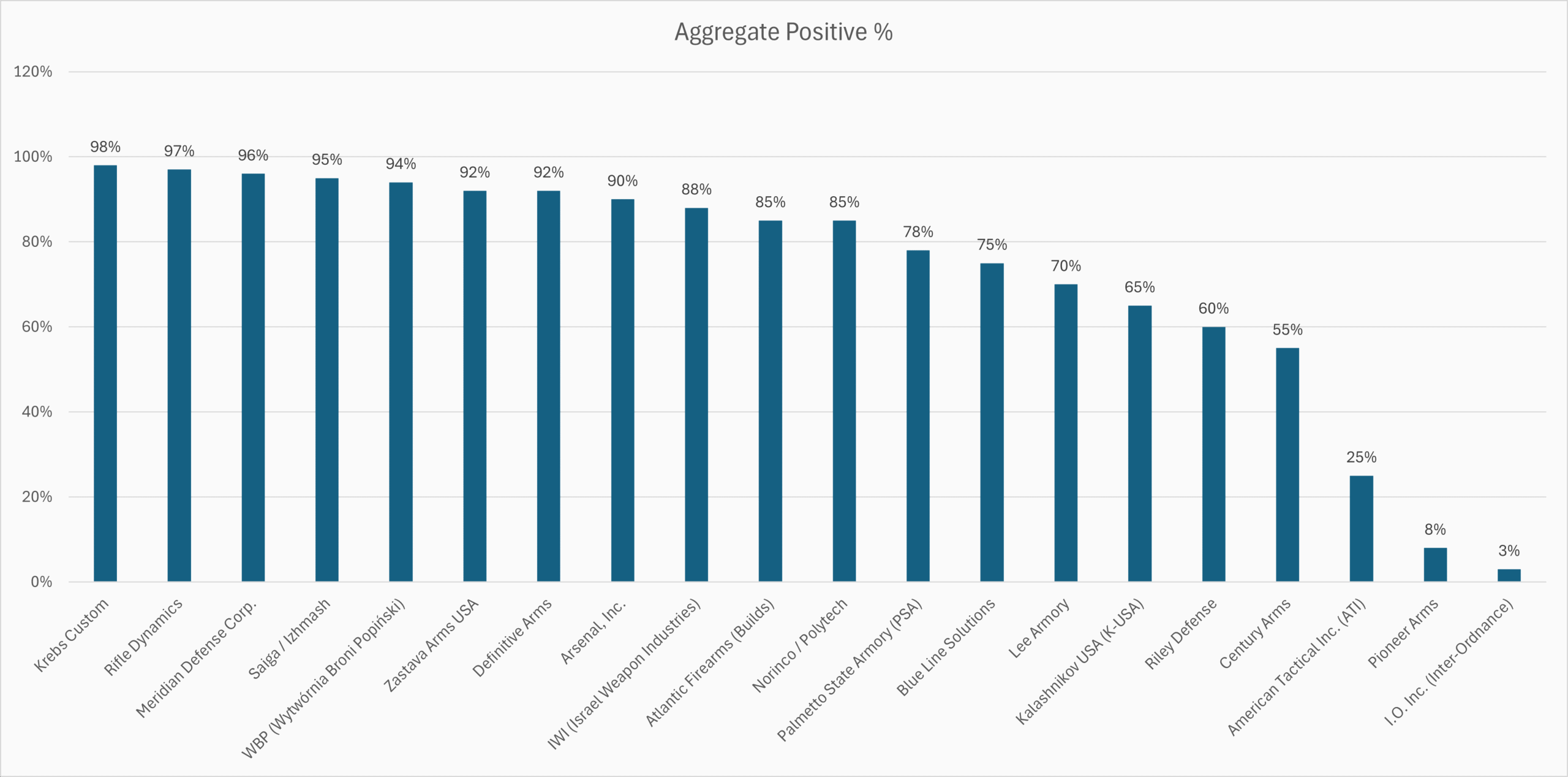
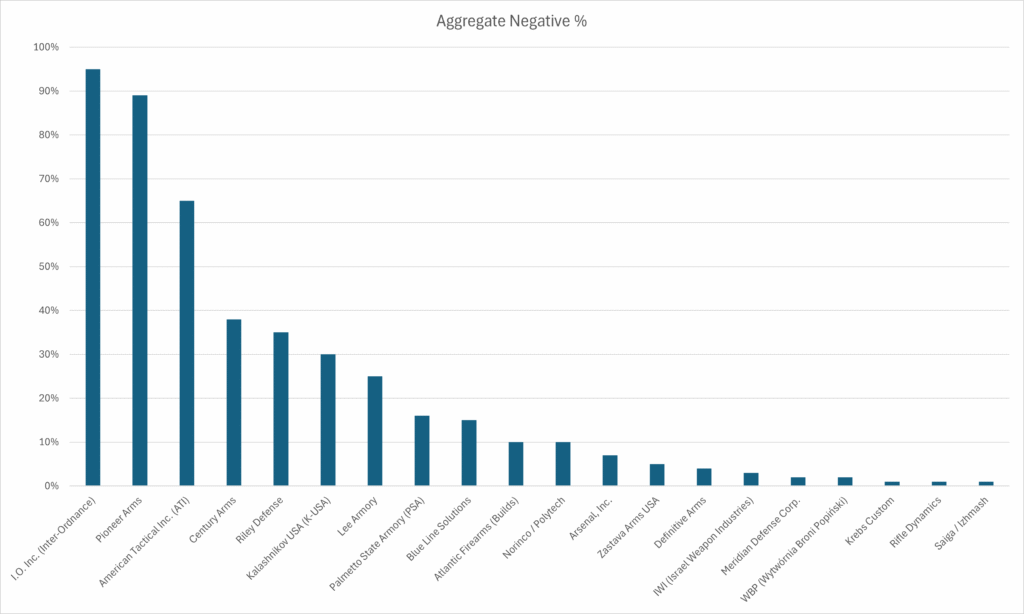
Table D: Master Data Table: Brand Mentions an d Sentiment Analysis by Year (2020-2025)
This table provides the granular, year-over-year data that underpins the report’s analysis. For brevity in this format, a selection of the top 5 brands is presented to illustrate the trends. A full version would include all 50 identified brands.
| Brand | Model | Year | Total Mentions | Positive % | Negative % | Neutral % | Key Positive Drivers | Key Negative Drivers |
| Palmetto State Armory | GF3 | 2020 | 3,500 | 65% | 25% | 10% | Forged Trunnion, Price | QC, Skepticism, Gen2 Legacy |
| GF3/GF4 | 2021 | 5,000 | 75% | 18% | 7% | Reliability Reports, Value | Firing Pin Issues, Mag Fit | |
| GF5/AK-103 | 2022 | 7,500 | 80% | 15% | 5% | FN Barrel, Features, Warranty | QC Lemons, 5.45 Issues | |
| All Models | 2023 | 9,000 | 82% | 14% | 4% | Market Dominance, Variety | QC, Firing Pin Complaints | |
| All Models | 2024 | 11,000 | 85% | 12% | 3% | Proven Track Record, Price | QC, Complex Product Line | |
| All Models | 2025 (YTD) | 6,500 | 86% | 11% | 3% | Availability, Value | N/A | |
| Century Arms | VSKA | 2020 | 4,000 | 30% | 65% | 5% | S7 Steel, Price | RAS-47 Legacy, Cast Fears |
| WASR-10 | 2020 | 4,500 | 85% | 10% | 5% | Reliability, CHF Barrel | Bad Furniture, Rough Finish | |
| VSKA | 2021 | 3,800 | 40% | 55% | 5% | Improved Reviews, RAK-1 | Distrust, Headspace Fears | |
| WASR-10 | 2021 | 4,800 | 88% | 8% | 4% | Workhorse Reputation | Price Increase, Finish | |
| BFT47 | 2022 | 2,000 | 60% | 30% | 10% | Forged Trunnion | Century Reputation | |
| WASR-10 | 2022 | 5,000 | 90% | 7% | 3% | Proven Durability | Finish, Price | |
| All US Made | 2023 | 5,500 | 45% | 50% | 5% | BFT47, Price | VSKA Skepticism, QC | |
| All Import | 2023 | 5,500 | 89% | 8% | 3% | Reliability, Value | N/A | |
| All US Made | 2024 | 5,000 | 48% | 47% | 5% | Price | Persistent Distrust | |
| All Import | 2024 | 5,000 | 90% | 7% | 3% | Reliability, Availability | N/A | |
| Zastava Arms USA | ZPAP M70 | 2020 | 6,000 | 90% | 6% | 4% | Build Quality, CHF Barrel | Yugo Pattern, Availability |
| ZPAP M70 | 2021 | 8,000 | 94% | 4% | 2% | Best Value, Durability | Yugo Pattern, QC Complaints | |
| ZPAP M70 | 2022 | 8,500 | 93% | 5% | 2% | Tank-like Build, Finish | QC Complaints, Yugo Parts | |
| ZPAP M70 | 2023 | 8,800 | 95% | 3% | 2% | Gold Standard Import | Yugo Pattern | |
| ZPAP M70 | 2024 | 8,000 | 94% | 4% | 2% | Reliability, Quality | N/A | |
| ZPAP M70 | 2025 (YTD) | 500 | 80% | 10% | 10% | N/A | Export Ban Uncertainty | |
| Arsenal, Inc. | SAM7 Series | 2020 | 5,000 | 95% | 3% | 2% | Milled Receiver, Quality | Price, Availability |
| SAM7 Series | 2021 | 6,000 | 92% | 5% | 3% | “The Best”, Accuracy | Price, Finish Complaints | |
| SAM7/SLR | 2022 | 6,500 | 90% | 7% | 3% | Resale Value, Durability | Price, Customer Service | |
| SAM7/SLR | 2023 | 6,800 | 88% | 9% | 3% | Prestige, Reliability | Warranty Issues, Price | |
| SAM7/SLR | 2024 | 6,500 | 87% | 10% | 3% | Milled Quality | Customer Service, Price | |
| AK-20 | 2025 (YTD) | 450 | 70% | 15% | 15% | Modern Features, Accuracy | Price, Non-traditional | |
| Kalashnikov USA | KR-103 | 2020 | 2,000 | 88% | 8% | 4% | Russian Specs, Quality | Availability |
| KR-103 | 2021 | 4,000 | 92% | 5% | 3% | Great Reviews, Reliability | Price | |
| KR-103/KP-9 | 2022 | 5,000 | 85% | 10% | 5% | Authenticity, Performance | QC Issues Emerging | |
| All Models | 2023 | 3,000 | 20% | 75% | 5% | N/A | Bankruptcy, Bad CS, QC | |
| All Models | 2024 | 1,500 | 5% | 90% | 5% | N/A | Bankruptcy, No Warranty | |
| All Models | 2025 (YTD) | 0 | – | – | – | N/A | Defunct |
In Closing
Over 500,000 conversations on US social media were analyzed to create this report. The intent is to let you see the tone of conversations across the vendors who account for the most social media discussions. I hope you found this analysis useful. I plan on doing more analyses and would welcome feedback.
Works cited
- AK47 Showdown: Who Makes the Best AK47 | PSA AK 47 | WASR AK | Yugo AK – We The People Holsters, accessed July 12, 2025, https://wethepeopleholsters.com/blogs/news/ak47-showdown-who-makes-the-best-ak47
- Best AK-47 Buyer’s Guide [Field Tested] – Gun Digest, accessed July 12, 2025, https://gundigest.com/rifles/the-best-ak-47-rifles-you-can-find-in-the-u-s
- Review: Century Arms WASR-10 Rifle | An Official Journal Of The NRA – Shooting Illustrated, accessed July 12, 2025, https://www.shootingillustrated.com/content/review-century-arms-wasr-10-rifle/
- Problem with PSAK Rivets? – Page 3 – AK-47 / AK-74 – Palmetto State Armory | Forum, accessed July 12, 2025, https://palmettostatearmory.com/forum/t/problem-with-psak-rivets/30814?page=3
- What’s a good make of AK-47 that you guys would recommend? : r/CAguns – Reddit, accessed July 12, 2025, https://www.reddit.com/r/CAguns/comments/owb4oi/whats_a_good_make_of_ak47_that_you_guys_would/
- Best AK-47 Rifles [Tested] – Pew Pew Tactical, accessed July 12, 2025, https://www.pewpewtactical.com/best-ak-47/
- American-Made AK-47 Rifles Compete – Gun Tests, accessed July 12, 2025, https://www.gun-tests.com/rifles/american-made-ak-47-rifles-compete-4/
- Why I wrote this Buyers Guide – How to Buy an AK-47, accessed July 12, 2025, https://howtobuyanak47.com/about/
- Prvi Partizan, Zastava Problems: Serbia Shuts Down Ammo, Gun Exports – Guns.com, accessed July 12, 2025, https://www.guns.com/news/2025/06/25/prvi-partizan-zastava-problems-serbia-shuts-down-ammo-gun-exports
- 10 Best AK-47s for Any Budget: Buyers Guide :: Guns.com, accessed July 12, 2025, https://www.guns.com/news/best-available-ak-rifles-and-pistols-today
- Is the AK platform dying? (Zastava banned form imports) : r/Firearms – Reddit, accessed July 12, 2025, https://www.reddit.com/r/Firearms/comments/1lt0q0g/is_the_ak_platform_dying_zastava_banned_form/
- Thoughts on Kalashnikov USA filing for bankruptcy – Palmetto State Armory, accessed July 12, 2025, https://palmettostatearmory.com/forum/t/thoughts-on-kalashnikov-usa-filing-for-bankruptcy/36840
- The 6 Best AK Rifles of 2025 (Tested) – Core Vision Training, accessed July 12, 2025, https://www.corevision-training.com/blog/best-ak-47-rifles
- ZPAP M70 Underfolder AK Review: Zastava’s Serbian Red Classic Rocks – Guns.com, accessed July 12, 2025, https://www.guns.com/news/reviews/zastava-zpap-m70-underfold-ak-review
- Century Arms VSKA Review [2023]: Best AK47? – Gun University, accessed July 12, 2025, https://gununiversity.com/century-arms-vska-review/
- AK-GF4 Rifle | New Gun for 2020 | PSA – Palmetto State Armory, accessed July 12, 2025, https://palmettostatearmory.com/blog/psa-ak-gf4-new-gun-for-2020.html
- Official PSA AK 47 Pictures thread : – Page 17 – AK-47 / AK-74 – Palmetto State Armory | Forum, accessed July 12, 2025, https://palmettostatearmory.com/forum/t/official-psa-ak-47-pictures-thread/179?page=17
- [Review] Palmetto State Armory AK-47 (PSAK-47 GF3) with Video – Pew Pew Tactical, accessed July 12, 2025, https://www.pewpewtactical.com/palmetto-state-armory-ak-47-psak-47-review/
- Zastava AK NPAP rifle – what went wrong?! – AK Operators Union, Local 47-74, accessed July 12, 2025, https://www.akoperatorsunionlocal4774.com/2015/05/zastava-ak-npap-rifle-what-went-wrong/
- 7 Best AK-47 Rifles You Can Buy for Under $1500 in 2025, accessed July 12, 2025, https://gununiversity.com/5-best-ak-47-rifles-under-800/
- Best Budget AKs – Guns.com, accessed July 12, 2025, https://www.guns.com/news/best-budget-ak-47s
- SAM7SF-84E 7.62x39mm Semi-Automatic Rifle with Enhanced Fire Control Group – Arsenal, Inc., accessed July 12, 2025, https://www.arsenalinc.com/usa/sam7sf-84e
- Top 20 AK Rifles & Soviet Weapons [2023] – Athlon Outdoors, accessed July 12, 2025, https://athlonoutdoors.com/article/running-red-20-top-ak-47s-soviet-weapons/
- Krebs Custom AK Fore End | The Armory Life Forum, accessed July 12, 2025, https://www.thearmorylife.com/forum/threads/krebs-custom-ak-fore-end.22085/
- EMG Rifle Dynamics Quickhatch AK PDW | Review – YouTube, accessed July 12, 2025, https://www.youtube.com/watch?v=UJFtl4ua_As
- BD2-AK – Meridian Defense Corp, accessed July 12, 2025, https://meridiandefensecorp.com/bd2-ak/
- Palmetto State Armory AK-47 : r/guns – Reddit, accessed July 12, 2025, https://www.reddit.com/r/guns/comments/1ercb8x/palmetto_state_armory_ak47/
- PSA AK47’s : r/PalmettoStateArms – Reddit, accessed July 12, 2025, https://www.reddit.com/r/PalmettoStateArms/comments/18k6lln/psa_ak47s/
- Kalashnikov rifle – Wikipedia, accessed July 12, 2025, https://en.wikipedia.org/wiki/Kalashnikov_rifle
- Palmetto State Armory’s exciting new AKs for 2020 – Recoil Magazine, accessed July 12, 2025, https://www.recoilweb.com/palmetto-state-armorys-exciting-new-aks-for-2020-157733.html
- [Tested+Review] PSA AKV | AK-V the Best AK9 on the Market? – Lynx Defense, accessed July 12, 2025, https://lynxdefense.com/reviews/psa-akv/
- PSA AKV Review: Best 9mm AK?, accessed July 12, 2025, https://www.pewpewtactical.com/palmetto-state-armory-psa-9mm-akv/
- Problem with PSAK Rivets? – Page 4 – AK-47 / AK-74 – Palmetto State Armory | Forum, accessed July 12, 2025, https://palmettostatearmory.com/forum/t/problem-with-psak-rivets/30814?page=4
- I know the PSA AKs are horrible, but how are the AK-V 9mm? : r/liberalgunowners – Reddit, accessed July 12, 2025, https://www.reddit.com/r/liberalgunowners/comments/1ki6els/i_know_the_psa_aks_are_horrible_but_how_are_the/
- PSA AK-47 GF3-E Range Review – YouTube, accessed July 12, 2025, https://m.youtube.com/watch?v=xlZGzmLyxBY
- Problem with PSAK Rivets? – Page 2 – AK-47 / AK-74 – Palmetto State Armory | Forum, accessed July 12, 2025, https://palmettostatearmory.com/forum/t/problem-with-psak-rivets/30814?page=2
- So many problems… : r/PalmettoStateArms – Reddit, accessed July 12, 2025, https://www.reddit.com/r/PalmettoStateArms/comments/1b76ezo/so_many_problems/
- Problem with PSAK Rivets? – #56 by Hangar18 – AK-47 / AK-74 – Palmetto State Armory, accessed July 12, 2025, https://palmettostatearmory.com/forum/t/problem-with-psak-rivets/30814/56
- Ak 102 failure to feed and extract – AK-47 / AK-74 – Palmetto State Armory | Forum, accessed July 12, 2025, https://palmettostatearmory.com/forum/t/ak-102-failure-to-feed-and-extract/21318
- AK 74 Cycling issues – Palmetto State Armory, accessed July 12, 2025, https://palmettostatearmory.com/forum/t/ak-74-cycling-issues/13713
- Best AK-47 | Ultimate AK-47 Roundup – Lynx Defense, accessed July 12, 2025, https://lynxdefense.com/best-ak-47/
- AK Rifles – Century Arms, accessed July 12, 2025, https://www.centuryarms.com/ak-rifles
- AK Rifles – Import – Firearms – Century Arms Store, accessed July 12, 2025, https://store.centuryarms.com/century/century-firearms/ak-rifles-import
- [Rifle] Century Arms RH10 Romanian AK-47 for $589.59 + Shipping with code “Save12” : r/gundeals – Reddit, accessed July 12, 2025, https://www.reddit.com/r/gundeals/comments/fcgkbd/rifle_century_arms_rh10_romanian_ak47_for_58959/
- Century Arms Russian-Red VSKA Review: Budget Pick to Scratch the AK-47 Itch?, accessed July 12, 2025, https://www.guns.com/news/reviews/century-arms-vska-ak-47-review
- The Cugir WASR-10: Function Over Form – Gun Digest, accessed July 12, 2025, https://gundigest.com/gun-reviews/military-firearms-reviews/the-cugir-wasr-10-function-over-form
- Century’s Classic Romanian AKM — The WASR-10 – The Mag Life – GunMag Warehouse, accessed July 12, 2025, https://gunmagwarehouse.com/blog/centurys-classic-romanian-akm-the-wasr-10/
- Century Arms WASR-10 Review: Best Romanian AK? – Pew Pew Tactical, accessed July 12, 2025, https://www.pewpewtactical.com/century-arms-wasr-10-review/
- [Rifle] Century Arms WASR 10 V2 7.62×39 AK-47 – Poly Stock – $745.13 + $29.99 Shipping, accessed July 12, 2025, https://www.reddit.com/r/gundeals/comments/z5qap3/rifle_century_arms_wasr_10_v2_762x39_ak47_poly/
- Why are Century Arms AK rifles universally hated? Are they really as bad as everyone says? : r/guns – Reddit, accessed July 12, 2025, https://www.reddit.com/r/guns/comments/11xlb1x/why_are_century_arms_ak_rifles_universally_hated/
- Is the Century Arms VSKA bad? : r/guns – Reddit, accessed July 12, 2025, https://www.reddit.com/r/guns/comments/wi63j3/is_the_century_arms_vska_bad/
- Do you all hate VSKA too? : r/liberalgunowners – Reddit, accessed July 12, 2025, https://www.reddit.com/r/liberalgunowners/comments/nobxxi/do_you_all_hate_vska_too/
- Thoughts on Century Arms? : r/Firearms – Reddit, accessed July 12, 2025, https://www.reddit.com/r/Firearms/comments/uhgpel/thoughts_on_century_arms/
- In your opinion, is the Zavasta M70 (AK) a good rifle? How would you rate its accuracy, reliability, and over all quality? Is it better than other AK’s in the same price range (PSAK, Century Arms, etc.)? – Quora, accessed July 12, 2025, https://www.quora.com/In-your-opinion-is-the-Zavasta-M70-AK-a-good-rifle-How-would-you-rate-its-accuracy-reliability-and-over-all-quality-Is-it-better-than-other-AK-s-in-the-same-price-range-PSAK-Century-Arms-etc
- What’s your opinion on the M70 Zastava rifle? – Quora, accessed July 12, 2025, https://www.quora.com/Whats-your-opinion-on-the-M70-Zastava-rifle
- Brand new ZPAP issues : r/zastavaarms101 – Reddit, accessed July 12, 2025, https://www.reddit.com/r/zastavaarms101/comments/14oa4nf/brand_new_zpap_issues/
- Zastava Zpap: Quality Control Problems On The Rise!? Still worth it? M90 M70 M92 M85 Model Problems! : r/guns – Reddit, accessed July 12, 2025, https://www.reddit.com/r/guns/comments/q1ehqp/zastava_zpap_quality_control_problems_on_the_rise/
- Zastava M70 assault rifle – Wikipedia, accessed July 12, 2025, https://en.wikipedia.org/wiki/Zastava_M70_assault_rifle
- Zastava ZPAP: Zero Compromises – Gun Digest, accessed July 12, 2025, https://gundigest.com/gun-reviews/military-firearms-reviews/zastava-zpap-zero-comprimises
- Review: Zastava ZPAP M70 Rifle | An Official Journal Of The NRA – Shooting Illustrated, accessed July 12, 2025, https://www.shootingillustrated.com/content/review-zastava-zpap-m70-rifle/
- Arsenal, Inc. > Rifles > SAM7 Series 7.62x39mm caliber Bulgarian milled rifle, accessed July 12, 2025, https://www.arsenalinc.com/usa/firearms/rifles/sam7-series/
- My Experience with the Arsenal SLR106 AK-74 Rifle – The K-Var Armory, accessed July 12, 2025, https://blog.k-var.com/reviews/rifles/arsenal/my-experience-with-the-arsenal-slr106-ak-47-rifle/
- AK-20: The Revolution of the AK – The K-Var Armory, accessed July 12, 2025, https://blog.k-var.com/reviews/ak-20-the-revolution-of-the-ak/
- After SHOT: A quick look at the Arsenal Inc AK-20 – Recoil Magazine, accessed July 12, 2025, https://www.recoilweb.com/after-shot-a-quick-look-at-the-arsenal-inc-ak-20-157886.html
- Arsenal SAM7SF-84E 7.62x39mm Semi-Automatic Rifle with Enhanced Fire Control Group, accessed July 12, 2025, https://www.k-var.com/arsenal-sam7sf-762×39-milled-receiver-ak47-black
- Dispelling an AK myth – Modern Service Weapons, accessed July 12, 2025, https://modernserviceweapons.com/?p=11422
- [Rifle] Arsenal SAM7SF-84E 7.62x39mm $1999.99 : r/gundeals – Reddit, accessed July 12, 2025, https://www.reddit.com/r/gundeals/comments/xm0gbi/rifle_arsenal_sam7sf84e_762x39mm_199999/
- Arsenal Inc. | BBB Complaints | Better Business Bureau, accessed July 12, 2025, https://www.bbb.org/us/nv/las-vegas/profile/gun-dealers/arsenal-inc-1086-75206/complaints
- PSA! Why You DON’T Want to Buy An Arsenal AK47 If you Live in California! – Reddit, accessed July 12, 2025, https://www.reddit.com/r/CAguns/comments/16dt2wc/psa_why_you_dont_want_to_buy_an_arsenal_ak47_if/
- KR-103 SFS – 7.62x39mm Side Folding Rifle – Cold Hammer Forged – Kalashnikov USA, accessed July 12, 2025, https://kalashnikov-usa.com/product/kr-103sfs-7-62x39mm-rifle-side-folding/
- Kalashnikov USA KR-103 Review: Best American-Made AK?, accessed July 12, 2025, https://www.pewpewtactical.com/kalashnikov-usa-kr-103-review/
- KR-103FT – 7.62x39mm Rifle – Kalashnikov USA, accessed July 12, 2025, https://kalashnikov-usa.com/product/kr-103-7-62x39mm-rifle/
- KR-9 broken : r/KalashnikovUSAowners – Reddit, accessed July 12, 2025, https://www.reddit.com/r/KalashnikovUSAowners/comments/1199t49/kr9_broken/
- Are Polish AK-47s Worth the Money? The WBP Jack Review – YouTube, accessed July 12, 2025, https://www.youtube.com/watch?v=ECneImQIXoQ
- WBP Fox AK47 Rifle – 7.62×39 – Arms of America, accessed July 12, 2025, https://armsofamerica.com/wbp-fox-ak47-rifle-7-62×39/
- first AK47, Zastava Arms ZPAP M70 : r/CAguns – Reddit, accessed July 12, 2025, https://www.reddit.com/r/CAguns/comments/11lrc88/first_ak47_zastava_arms_zpap_m70/
- Buying an AK. What are some suggestions for a good one? : r/liberalgunowners – Reddit, accessed July 12, 2025, https://www.reddit.com/r/liberalgunowners/comments/1cv34pn/buying_an_ak_what_are_some_suggestions_for_a_good/
- Looking for a AK style gun that isn’t gonna break the bank : r/NJGuns – Reddit, accessed July 12, 2025, https://www.reddit.com/r/NJGuns/comments/1loluaa/looking_for_a_ak_style_gun_that_isnt_gonna_break/
- Testimonials – Riley Defense, accessed July 12, 2025, https://rileydefense.com/testimonials/
- Pioneer Arms is back? Unboxing the cheapest AK of 2025…again – YouTube, accessed July 12, 2025, https://www.youtube.com/watch?v=cHr37hIVTSE
- Essebo’s Review of Pioneer Arms Hand Polished Fire Control Group AK-47 Trigger, accessed July 12, 2025, https://www.opticsplanet.com/reviews/reviews-pioneer-arms-hand-polished-fire-control-group-ak-47-trigger/c6f29410-92d8-11ee-a468-0a757d5ad4cc.html
- Psa 103 terrible review. What gives? – General Discussion – Palmetto State Armory | Forum, accessed July 12, 2025, https://palmettostatearmory.com/forum/t/psa-103-terrible-review-what-gives/24499
- I.O. INC. Rifles for Sale – Buds Gun Shop, accessed July 12, 2025, https://www.budsgunshop.com/search.php/type/rifles/manu/1428
- Krebs M23 AK: Possibly the most modern “Space AK” in 2023. Part 2 – YouTube, accessed July 12, 2025, https://www.youtube.com/watch?v=bX-uNphXalM
- AK Models: Ultimate Guide to Kalashnikov Rifles – Pew Pew Tactical, accessed July 12, 2025, https://www.pewpewtactical.com/ak-models/
